Sandy Wright's Blog, page 5
July 6, 2020
Stockpile for Disaster
 I have never considered myself a “prepper” who stockpiles goods and materials for a future disaster. But I think this year has made all of us preppers to some extent. And judging by the new infection numbers being racked up (more than 4,400 new cases today) in Arizona, it looks like we’re in for another lockdown.
I have never considered myself a “prepper” who stockpiles goods and materials for a future disaster. But I think this year has made all of us preppers to some extent. And judging by the new infection numbers being racked up (more than 4,400 new cases today) in Arizona, it looks like we’re in for another lockdown.We will be smarter this time. Won’t we?
Look at what FEMA has recommended for survival situations in the past. Their stance is you only need to be ready to take care of yourself for three days. That’s their target reaction time. At the end of three days, FEMA supposedly will have assistance in place. There’s only one problem: That model doesn’t work. There were people digging in dumpsters, looking for food, six weeks after both Hurricane Katrina and Sandy. And I have even less faith that it will be safe to resume normal shopping activities any time soon during this pandemic, even if the stores remain well-stocked.
When selecting food for a lock-down situation, there are several things to take into consideration. This isn’t buying your regular week’s groceries multiplied by 10, but rather buying food that you will use instead of your regular groceries. As you are selecting food for your emergency stash, consider the following:
You can’t depend on having refrigerator and/or freezer space for two or three months’ worth of convenience and junk food.Most foods aren’t packaged for long-term storage, with the exception of canned foods.You want foods that will give you the maximum nutrition for minimum bulk.
What you really need to store are staple foods. You can make a fairly nutritious diet out of grains, beans and canned goods. Properly packages for storage, these foods will keep for years, and still be as tasty and nutritious when you take them out, as they were when you bought them.
Here is what I consider the most important ones:
Beans. This is one of the more common survival foods. Not only are beans plentiful and cheap, but they provide a lot of protein—something hard to find without eating meat.White rice. The perfect companion to beans, it’s an excellent source of carbohydrates, and it stores well. (Note: don’t store brown rice, which contains oil and will spoil.)Canned vegetables and fruit. A good way of adding micro-nutrients to your lock-down diet. Canned goods keep well, long past the expiration date on the label. Don’t throw the packing water away, as it contains vitamins also, and you can use it to make soup stock.Soups. The nice thing about having soup on your shelf in a lock-down situation is that you can use it in almost anything. Think beyond chicken noodle and check out others, such as cream of mushroom.Canned meats. Of all the ways of preserving meat, canning is the most secure in protecting the meat from decomposition. While it doesn’t typically have as good a flavor as fresh meat, it still provides animal protein at the most reasonable price you’ll find. Consider chicken, tuna, and salmon as well as spam and deviled ham. Meat may be the hardest type of food to find during a crisis, so stock up.Powdered milk. While most people don’t particularly like the flavor of powdered milk, when you don’t have access to other milk, it’s wonderful. It’s also necessary for baking and provides needed calcium for proper bone growth.Cheese. Another great source of protein. To store cheese, it needs to be triple dipped in wax, making an airtight seal around the cheese. In this form, it can be kept, without refrigeration, for years. Even if the cheese forms mold, it will only be on the surface. Simply cut that part of and the rest of the cheese is still good.Sugar. Yes, we try and stay away from eating too much sugar, but it’s an essential ingredient in making jam and for preserving fruit. You will also need it for baking. And sugar will keep pretty much indefinitely if stored properly.Molasses. (Note: If you want brown sugar, just combine your molasses and white sugar).Honey. Whereas sugar will last indefinitely, honey will really keep forever, as long as you keep the ants out of it. Plus, it is beneficial to help stave off colds and infection.Salt. Most means of preserving foods require the use of salt, and our bodies need it for survival.Spices. Stock up on the spices your family likes, as well as any you’ll need for cooking and baking.Nuts. A good source of both protein and fat, nuts store well.Cooking oil and vegetable shortening. Our family doesn’t normally use Crisco, but an unopened metal can of it will last for 5 years! It can also be used to make emergency candles. If you’d prefer a lighter oil for your food, coconut and olive oil both last about 24 months tightly capped in a cool, out of the light location.Coffee and tea. Comfort food for adults. Keep your favorites on stock at all times.Rolled Oats. You can prepare breakfast cereals and other dishes. Store in dark, airtight container with an oxygen absorber.Pasta products. Pasta is a great source of carbohydrates, and it allows a wide variety of eating. Even your kids will eat it.Spaghetti sauce. Obviously, you need this to go with the pasta. But it’s also great for hiding the flavor of things your family doesn’t like to eat—whether you’re talking about an unusual vegetable or leftovers you’re re-presenting.Jerky. While expensive to buy, jerky is pure meat with only added spices. Its high salt content allows it to store well, making it a great pandemic food. It can be reconstituted by adding it to soups and allowing it to cook.Summer sausage. Like many ‘cured meat products’, it’s created to keep for a long time.Peanut butter. Another good source of protein and a great comfort food, especially for the kids. Maybe you should stockpile some no-sugar-added jelly with it.Wheat flour. For baking, especially baking bread. Flour also allows you to shake up the diet with the occasional batch of cookies or a cake.Baking powder & baking soda. Also good for making bread, cookies and cakes.Bouillon. This ‘soup starter’ allows you to make broth without having to boil bones on the stove for hours. Soups will probably be an important part of anyone’s diet in a stay-home situation, as it allows you to eat almost anything. Just throw it together in a pot and it’s soup.Hard candies. These are useful as a reward for kids and also for quick energy (or emergency sugar if you have a diabetic in your household). The candy will keep for years as long as they are protected from moisture.Most essential paper products: Toilet paper and tissues are my “must haves.” You may want to add paper towels if you don’t have a huge supply of cleaning rags like I do.Light bulbs. Take an inventory of your home, and have a package of every kind you use in your lights.Batteries. Again, inventory your electronics, medical supplies, and so on. Don’t forget your keyboard and mouse, as well as the TV remote!Battery charger for your car.Hand sanitizer, household wipes, and soap.Water. Don’t forget to stockpile a good supply of water. You’ll go through much more than you expect. Experts recommend a minimum of one gallon per person per day, but remember: That’s just for drinking.
Try creating a three-week menu, with the idea of repeating that menu over and over. If you have the supplies you need to cook everything on that menu, you’ll have a fair assortment of food, and enough so your family shouldn’t grow tired of it.
Whatever you do, don’t try to run out and buy a year’s worth of food in one week. Take your time. Start by building a 2-week stockpile; then increase it to a month. Keep your eyes open for sales and other opportunities to save money.
Published on July 06, 2020 13:02
June 29, 2020
Air My Breath
 I’ve been thinking a lot about air lately, in all of its attributes.
I’ve been thinking a lot about air lately, in all of its attributes.In my spirituality, the element of Air with a capital A is not just that invisible H20 gas that surrounds our planet. It’s a whole list of human and earthly traits that describe our world.
Air is the benefactor of breath,
Keeper of the fragile atmospheric bridge we breathe across.
Air, waiting outside the womb, to funnel the first breath,
drawn from its invisible stock, to wail.
Supporter of birds, bees, butterflies, and any other creature possessing wings.
Air, that wafts scents that stir our taste buds, as well as our memories.
Air, along whose unseen path voices come to us in waves.
Voices that can persuade every door of the heart open, in tides of music that erases time.
Air, vast expansive neighborhood of the invisible,
Where thought lives,
Entering us as voice to our own ideas,
Enabling us to put names and faces on things
That would otherwise stay forever unrecognized. Unnamed.
Home of memory, where our vanished days secretly gather,
Taking all our unfolding in, so that nothing is lost or forgotten.
Except, nothing’s perfect; we do forget.
Air, counting our breaths to meditate,
To let go of the past,
Or reduce anxiety about the future.
To control pain of contractions,
Or a flare of anger.
Air, Kingdom of spirit,
Breathing prayers to
Where our departed dwell.
 Thousands nearer to us now than when they departed,
Thousands nearer to us now than when they departed, Their breathing tainted.
Forced to take their last breath.
Alone.
Air is an intimate element.
It gets right into you,
through your breathing and your blood.
We’ve taken it for granted,
And we’ve tried to repair what we ruined.
But few saw this coming.
At least I didn’t.
Unfortunately, we can’t do without,
You know, Air.
 Air, always there,
Air, always there,May fix herself, if we let her.
Leave her alone. Get out of her way.
Give her time
To heal.
Blessed Be.
Published on June 29, 2020 10:38
June 21, 2020
Virtual Solstice at Stonehenge
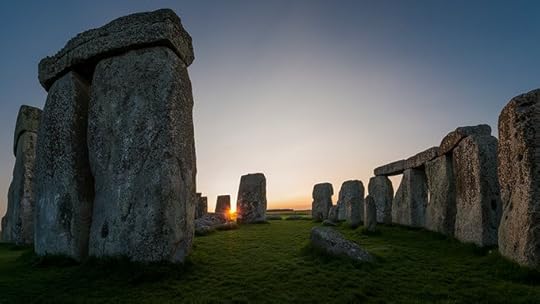 In normal times, thousands of people would flock to the iconic prehistoric stone monument of Stonehenge in Wiltshire, southwestern England to celebrate the Summer Solstice in a tradition that has been observed for millennia and still carries spiritual importance for modern-day pagans.
In normal times, thousands of people would flock to the iconic prehistoric stone monument of Stonehenge in Wiltshire, southwestern England to celebrate the Summer Solstice in a tradition that has been observed for millennia and still carries spiritual importance for modern-day pagans.Due to the coronavirus pandemic, however, English Heritage—the organization that manages the monument—cancelled the celebrations. In fact, Stonehenge has been closed since March 18, 2020, as the British government introduced measures to combat the coronavirus pandemic.
Instead, they provided a livestream of sunset and sunrise at Stonehenge on June 20 and June 21 respectively.
My husband and I hopped onto the live feed last night, along with about 50,000 other virtual visitors, to see the sunrise rays stream through the famous Neolithic monument. Unfortunately, the sunrise was masked by clouds. But Stonehenge is beautiful non-the-less, and it was interesting to watch the comments scroll along the live feed. People commented from South Africa, Australia, Brazil, Columbia, and all over Europe, as well as Canada and all points in the United States. Many of the viewers had been to the Summer Solstice celebration in previous years, and hoped they’d be able to attend again in person.
Stonehenge was built in three phases between about 3,000 B.C. and 1,600 B.C., and its purpose remains under study. However, it’s known that if you stand in just the right place inside the Stonehenge monument on the day of the northern summer solstice, facing northeast through the entrance towards a rough-hewn stone outside the circle—known as the Heel Stone—as illustrated in the image at the top.
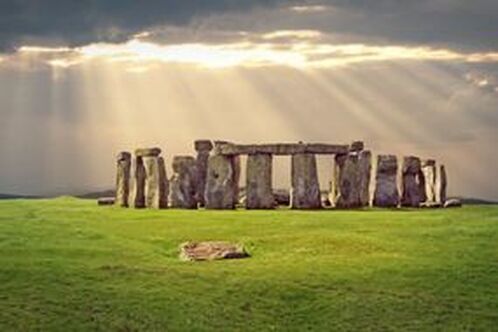 This huge monolith shows how carefully our ancestors watched the sun. Astronomical observations such as these probably controlled human activities such as the mating of animals, the sowing of crops, and the metering of winter reserves between harvests.
This huge monolith shows how carefully our ancestors watched the sun. Astronomical observations such as these probably controlled human activities such as the mating of animals, the sowing of crops, and the metering of winter reserves between harvests.While most are not a famous as Stonehenge, similar giant stone monuments and other structures are scattered throughout England, Ireland and Scotland. A predominance of those monuments are aligned with painstaking precision to the rising and setting of the sun.
When Stonehenge was first opened to the public, visitors were able to walk among the stones—even climb on them. The stones were roped off in 1977 as a result of serious erosion. Today, visitors to the monument are not permitted to touch the stones, but, if you go, you will be able to walk around the monument from a short distance away. Visitors can also make special bookings to access the stones throughout the year.
Two recently discovered pits have been found at Stonehenge which point to it once being used as a place of worship before the stones were erected. The pits are positioned on celestial alignment at the site and may have contained stones, posts or fires to mark the rising and setting of the sun.
An international archaeological survey team found the pits are part of the Stonehenge Hidden Landscapes Project. The team is using geophysical imaging techniques to investigate the site.
It is thought the pits, positioned within the Neolithic Cursus pathway, could have formed a procession route for ancient rituals celebrating the sun moving across the sky at the Midsummer Solstice.
Archaeologists also discovered a gap in the northern side of the Cursus, which may have been an entrance and exit point for processions taking place within the pathway. These discoveries hint that the site was already being used as an ancient center of ritual prior to the stones being erected 5,000 years ago.
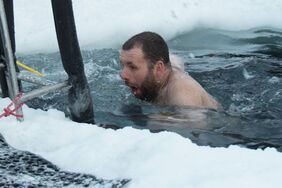 While June 21 is the summer solstice in Britain, for Australia and countries in the southern
While June 21 is the summer solstice in Britain, for Australia and countries in the southernhemisphere this date marks the winter solstice.
In Antarctica, members of the Australian Antarctic Division at the Casey research station marked the winter solstice with a traditional cutting through thick ice and taking a dip in the icy waters beneath.
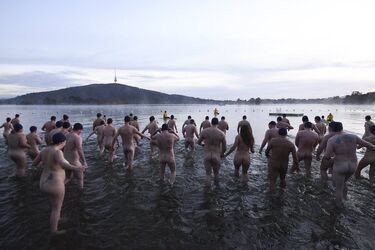 In Canberra, Australia, the winter solstice Nude Charity Swim took place in Lake Burley Griffin on the shortest day of the year.
In Canberra, Australia, the winter solstice Nude Charity Swim took place in Lake Burley Griffin on the shortest day of the year. Swimmers were accompanied by a bagpipe player as dawn broke. In Northern Arizona, near Sedona, is a site used our Native people to celebrate the Summer Solstice, the V-Bar-V Ranch. Established as a historical site about ten years ago, the V-Bar-V is home to a well-preserved and beautiful petroglyph site, created by the Sinagua Indians sometime between 1150 and 1400 AD.
Swimmers were accompanied by a bagpipe player as dawn broke. In Northern Arizona, near Sedona, is a site used our Native people to celebrate the Summer Solstice, the V-Bar-V Ranch. Established as a historical site about ten years ago, the V-Bar-V is home to a well-preserved and beautiful petroglyph site, created by the Sinagua Indians sometime between 1150 and 1400 AD. The photo was taken on location on June 21, first day of the summer solstice.
The photo was taken on location on June 21, first day of the summer solstice.Marking the passage of time across what is now believed to be a solar calendar or panel—one of very few worldwide—shadow stones naturally wedged in a rock crevice play light and shadow across the cliff face. The precise times of the vernal equinox and summer solstice, important events for planting and harvesting, are tracked by light and the sun’s transition across the southwestern sky.
No matter how you chose to celebrate (or not), I hope your Solstice was peaceful and full of warmth.
Published on June 21, 2020 19:06
June 15, 2020
Shedding Old Skin- Waning Moon Ritual
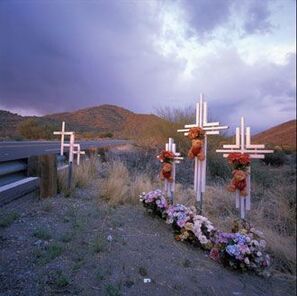 “Tears are words that need to be written.”
“Tears are words that need to be written.”~Paul Coelho~
In the book Women Who Run with the Wolves, Dr. Clarisa Pinkola Estes describes the folklore of “descansos.”
You’ve seen them, I’m sure: Little white crosses found by the side of the road in the Southwest states, Mexico, Greece, Italy and many other countries. They mark where someone’s life ended. Often they are decorated by the living who remember the deceased.
Estes describes exploring descansos by writing out the journey of her life, from beginning to present, on a large piece of paper. Where there is death, loss, transformation, pain or suffering, she lays or draws a cross (or a heart). These are places that need to be mourned, forgiven, released.
She says, “Descansos is a conscious practice that takes pity on and gives honor to the orphaned dead of your psyche.”
I was so pleased to see this tradition transformed into an actual ritual in another book I’m reading and reviewing, The Magical Writing Grimoire by Lisa Marie Basile.
I’m going to do her descansos based ritual for the upcoming dark moon (coincidentally on Father’s Day, June 21st), to recognize the hard parts of life, and help those dead memories, stagnant hopes, and jagged endings find their way out of limbo and into a place of rest.
This practice allows you to celebrate your life and your personal path, despite your pain.
Materials
An altar space
A bag of small votive candles
Flower petals of any variety, in colors that speak to you
Several small pieces of paper (however many you need)
___________
Basile recommends that you do this on a weekend or during a time you won’t be interrupted. You will be creating a funeral for that which has never been properly buried or mourned in your life. Use a space that feels safe and clear from intrusion. Sacred.
In silence, sketch out the journey of your life. Childhood. Adolescence. Memories of loss. Pain. Grief. Being made to feel invisible. Being abandoned. Having to persevere without assistance, support, or a friend. Having to wear the mask of survival when you’ve been beaten down. Times in which poverty or illness or systemic oppression cut your path short. Eras in which you were alone. Homes in which you felt scared. The map-making of your life is a changing and personal process.
Draw your crosses at the appropriate spots on your map.
The author suggests filling in your chart with your beautiful moments later on, after you’ve properly mourned for what you have lost and suffered.
Next, write each of your eras, memories, homes, or moments onto a piece of paper and cross them out. This should be symbolic, sacred. Breathe through it. Light a single candle for each, and arrange flower petals around the paper and candle. You may choose other spiritual relics as well. Intuit this. Beautify the graves of the selves. Take time for each and every one that you write.
Don’t feel like you have to play into the gloom if that’s not your way. Instead, you can play the music you used to love, talk to your old self, and laugh about their mistakes. There is room for it all. The mourning process plays out differently for each of us.
As you look upon the map of self, say at each point, “You are loved and laid to rest.” Of course, you can say more: A song, a poem, a remembrance. Just be sure you lay that point to rest.
Happy Summer Solstice, Father's Day and Waning Moon.
Blessed Be.
Published on June 15, 2020 01:05
June 7, 2020
A Dog's Job
 To be a dog.
To be a dog.To awaken each morning
With a smile on my mouth,
And begin my new favorite day.
To find fresh messages in the grass and on the trees,
And leave my replies in kind.
To greet each stranger knowing
He will be my next best friend.
To know, really know
That if at this moment
The walk I want is not ready to happen,
It will soon. My owner told me!
I will walk and I will run,
And root my nose under bushes and logs,
Because it’s today, and
I am a dog.
To be a dog is to run with abandon,
A stick in my mouth just because
I am outside, and sticks are outside toys
My master told me this, too.
I’ll roll in the dewy grass, and
Listen to the birds sing good morning,
And the butterflies and bugs flit and buzz.
When I catch one, its tastes like I’m on a wild adventure.
To be a dog is to do just what I want to do.
To never notice that I look strange
With a five-foot stick in my mouth.
To not care what I look like.
I’ll roll over and over in the muddy turf
At seven in the morning.
The cat will give me her aloof look
That says I’m insane.
But I don’t care.
I’m a dog.
Reckless play is part of my work.
Cat’s just jealous that she doesn’t have a job.
I never worry about the musts I must do.
That I must wait for my humans.
That I must wait for a full food dish.
That I must wear soap and take a bath.
I’m a dog.
I know there is another tomorrow
For walks and sticks and smells,
Waiting for me beyond that window.
~Dedicated to my best friends,
Woody, Sadie and Teak (sorry, Sadie wouldn't pose for this photo op)
Published on June 07, 2020 15:16
May 11, 2020
Mother's Day during Pandemic
“The last few months, many of us have been reminded that life—and especially parenting—rarely goes according to plan, Michelle Obama wrote in her Mother’s Day greeting yesterday.”
Here’s what is interesting about that sentiment: Every family is affected. Money doesn’t get you a “pass” here. Where in the world you live doesn’t matter. EVERY family is affected by this pandemic.
 Yes, the exact circumstances vary. Some mothers and fathers have been working tirelessly to get their families, workplaces, communities--and even our nation—through this crisis. Some parents have separated themselves from their families, because they are essential workers choosing to live apart from their kids and other family to keep them safe while they work to protect us from the virus.
Yes, the exact circumstances vary. Some mothers and fathers have been working tirelessly to get their families, workplaces, communities--and even our nation—through this crisis. Some parents have separated themselves from their families, because they are essential workers choosing to live apart from their kids and other family to keep them safe while they work to protect us from the virus.
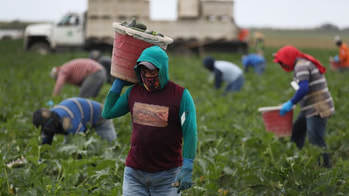 Other parents are doing any work they can, just to buy groceries and pay bills. So many people are struggling with the basics of survival, looking at the unemployment numbers, a staggeringly large number of people fall into this crisis category.
Other parents are doing any work they can, just to buy groceries and pay bills. So many people are struggling with the basics of survival, looking at the unemployment numbers, a staggeringly large number of people fall into this crisis category.
For the mothers (and grandparents) privileged enough to live free from harm at home with their family, the pandemic provides a chance to witness milestones that might otherwise have been missed. To be close and present in ways impossible when the family is in constant motion. To reconnect with older children we’ve reluctantly and necessarily let go their own way.
In the midst of suffering, there is opportunity.
This is a difficult time for parents right now. They are being asked to play all roles in the village. Not only that, but the activities are gone. No outings, movies, birthday parties or swimming pools. Sports are cancelled. We’re stripped back to simple play, to forts and art projects, even board games, bikes, and long walks with the dogs. Popcorn and TV movies every night. Maybe ice cream afterwards.
Stop. Did you read that? Carefully? In the midst of suffering, there IS opportunity.
It’s your opportunity to make up for lost time.
It’s an opportunity for deep healing.
It’s an opportunity to look to what you want to make important in the future, going forward.
 This seminal moment in our world history can have some profound effects in the near future. Among them are a renewed appreciation for science, a rekindled admiration for doctors and nurses, and a funding bonanza for health institutions such as the CDC, a once-mighty and now (especially under the current administration) woefully underfunded institution.
This seminal moment in our world history can have some profound effects in the near future. Among them are a renewed appreciation for science, a rekindled admiration for doctors and nurses, and a funding bonanza for health institutions such as the CDC, a once-mighty and now (especially under the current administration) woefully underfunded institution.
Our U.S. history shows that whatever rises to a level of national concern gets funding. I’m hoping that global health issues rise sky-high. Coronavirus is touching everyone, so what official won’t want to be prepared for the next outbreak?
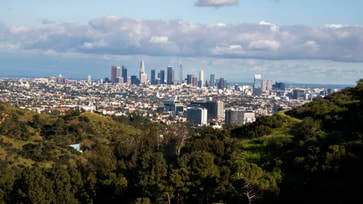 Angeles skyline --
Angeles skyline --
without smog.
The earth has shown us, in less than 2 months, that this can be our future.
Hopefully, another reaction to this historical turning point will be a more urgent focus on curbing climate change. No one looking at the worldwide pictures of astonishingly clean air and water around the world can doubt human’s hand in pollution any longer.
Another realization hitting Americans across the economic spectrum is how globally interconnected the economies of all nations have become.
 That phone you’re holding or the car you’re driving may be designed or built in the U.S., but countless of its parts and circuitry were made in countries whose manufacturing plants are now at risk as governments order shutdowns.
That phone you’re holding or the car you’re driving may be designed or built in the U.S., but countless of its parts and circuitry were made in countries whose manufacturing plants are now at risk as governments order shutdowns.
U.S. manufacturing ultimately will have to find new ways to make products—and for who knows how long?
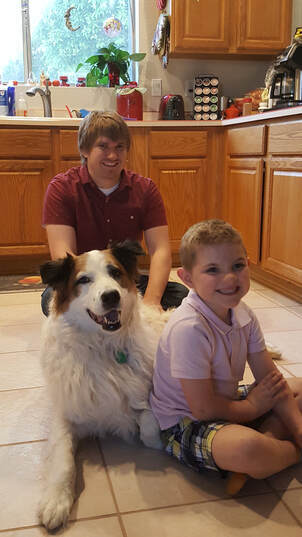 Son Ian, Grandson Alex, and Woody.
Son Ian, Grandson Alex, and Woody.
I think these challenges all have a positive slant.
Yes, they will be difficult and sometimes painful.
But in the midst of suffering there is opportunity. Let’s find it.
Together.
From my home to yours~
Happy Belated Mother’s Day to you all, and especially to those mothers who are also essential workers. Your extraordinary efforts are so appreciated!
Here’s what is interesting about that sentiment: Every family is affected. Money doesn’t get you a “pass” here. Where in the world you live doesn’t matter. EVERY family is affected by this pandemic.
 Yes, the exact circumstances vary. Some mothers and fathers have been working tirelessly to get their families, workplaces, communities--and even our nation—through this crisis. Some parents have separated themselves from their families, because they are essential workers choosing to live apart from their kids and other family to keep them safe while they work to protect us from the virus.
Yes, the exact circumstances vary. Some mothers and fathers have been working tirelessly to get their families, workplaces, communities--and even our nation—through this crisis. Some parents have separated themselves from their families, because they are essential workers choosing to live apart from their kids and other family to keep them safe while they work to protect us from the virus.
 Other parents are doing any work they can, just to buy groceries and pay bills. So many people are struggling with the basics of survival, looking at the unemployment numbers, a staggeringly large number of people fall into this crisis category.
Other parents are doing any work they can, just to buy groceries and pay bills. So many people are struggling with the basics of survival, looking at the unemployment numbers, a staggeringly large number of people fall into this crisis category. For the mothers (and grandparents) privileged enough to live free from harm at home with their family, the pandemic provides a chance to witness milestones that might otherwise have been missed. To be close and present in ways impossible when the family is in constant motion. To reconnect with older children we’ve reluctantly and necessarily let go their own way.
In the midst of suffering, there is opportunity.
This is a difficult time for parents right now. They are being asked to play all roles in the village. Not only that, but the activities are gone. No outings, movies, birthday parties or swimming pools. Sports are cancelled. We’re stripped back to simple play, to forts and art projects, even board games, bikes, and long walks with the dogs. Popcorn and TV movies every night. Maybe ice cream afterwards.
Stop. Did you read that? Carefully? In the midst of suffering, there IS opportunity.
It’s your opportunity to make up for lost time.
It’s an opportunity for deep healing.
It’s an opportunity to look to what you want to make important in the future, going forward.
 This seminal moment in our world history can have some profound effects in the near future. Among them are a renewed appreciation for science, a rekindled admiration for doctors and nurses, and a funding bonanza for health institutions such as the CDC, a once-mighty and now (especially under the current administration) woefully underfunded institution.
This seminal moment in our world history can have some profound effects in the near future. Among them are a renewed appreciation for science, a rekindled admiration for doctors and nurses, and a funding bonanza for health institutions such as the CDC, a once-mighty and now (especially under the current administration) woefully underfunded institution.Our U.S. history shows that whatever rises to a level of national concern gets funding. I’m hoping that global health issues rise sky-high. Coronavirus is touching everyone, so what official won’t want to be prepared for the next outbreak?
 Angeles skyline --
Angeles skyline --without smog.
The earth has shown us, in less than 2 months, that this can be our future.
Hopefully, another reaction to this historical turning point will be a more urgent focus on curbing climate change. No one looking at the worldwide pictures of astonishingly clean air and water around the world can doubt human’s hand in pollution any longer.
Another realization hitting Americans across the economic spectrum is how globally interconnected the economies of all nations have become.
 That phone you’re holding or the car you’re driving may be designed or built in the U.S., but countless of its parts and circuitry were made in countries whose manufacturing plants are now at risk as governments order shutdowns.
That phone you’re holding or the car you’re driving may be designed or built in the U.S., but countless of its parts and circuitry were made in countries whose manufacturing plants are now at risk as governments order shutdowns.U.S. manufacturing ultimately will have to find new ways to make products—and for who knows how long?
 Son Ian, Grandson Alex, and Woody.
Son Ian, Grandson Alex, and Woody.I think these challenges all have a positive slant.
Yes, they will be difficult and sometimes painful.
But in the midst of suffering there is opportunity. Let’s find it.
Together.
From my home to yours~
Happy Belated Mother’s Day to you all, and especially to those mothers who are also essential workers. Your extraordinary efforts are so appreciated!
Published on May 11, 2020 18:47
May 5, 2020
Books I'm Reading this Summer
I'm a book reviewer for NetGalley, which means I get copies of upcoming books to read and review before they are published. It's a lot of fun to get free books, but it also means I have a "To Be Read" list so long I'll never get through it!
Here is my list for the remainder of 2020--although I'm sure Netgalley will tempt me with some new fall titles soon.
I would love to hear from you! If one of these 16 books look like something you'd like to read, drop me a post reply and I'll post a full-length review later. If I don't love it or recommend after reading, I'll let you know that as well.
Happy reading~
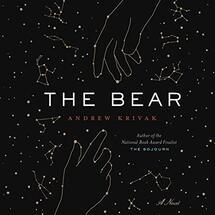 The Bear by Andrew Krivak (2020)
The Bear by Andrew Krivak (2020)
Category: Literary Fiction
I just finished this sweet story. It was perfect for these scary, uncertain times. Very earth and nature-based, but not hokey. "Thumbs up."
In an Eden-like future, a girl and her father live close to the land in the shadow of a lone mountain. They possess a few remnants of civilization: some books, a pane of glass, a set of flint and steel, a comb. The father teaches the girl how to fish and hunt, the secrets of the seasons and the stars. He is preparing her for an adulthood in harmony with nature, for they are the last of humankind.
But when the girl finds herself alone in an unknown landscape, it is a bear that will lead her back home through a vast wilderness that offers the greatest lessons of all, if she can only learn to listen.
A cautionary tale of human fragility, of love and loss, The Bear is a stunning tribute to the beauty of nature’s dominion.
Krivak delivers a transcendent journey into a world where all living things—humans, animals, trees—coexist in magical balance, forever telling each other’s unique stories. This beautiful and elegant novel is a gem.”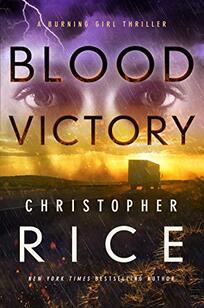 Blood Victory
by Christopher Rice (publication date: August 18, 2020)
Blood Victory
by Christopher Rice (publication date: August 18, 2020)
Category: Thriller, Horror
This is the 3rd book in the Burning Girl series (I’ve already enjoyed and reviewed Bone Music and Blood Echo).
The background: As the test subject of an experimental drug, Charlotte Rowe was infused with extraordinary powers. As the secret weapon of a mysterious consortium, she baits evil predators and stops them in their tracks. But it takes more than fear to trigger what’s coursing through Charlotte’s blood. She needs to be terrorized.
In this book, serial killer Cyrus Mattingly is up to the task.
Cyrus is a long-haul truck driver, and his cargo bay is a gallery of horrors on wheels. To stop his bloodshed, Charlotte will become his next victim, reining in her powers so she can face each of his evils in turn.
As much as they know about Cyrus—his method of selecting victims, his prolonged rituals—there is something they don’t. What happens on the dark and lonely highways is only the journey. It’s the destination that’s truly depraved. Before she can unleash vengeance on a scale this killer has never seen, Charlotte and her team will have to go the distance into hell. Cloud Warriors
by Rob Jung (2019)
Cloud Warriors
by Rob Jung (2019)
Category: Medical Thriller
Anthropology professor Terry Castro, leading a summer-school program in the Peruvian rain forest, stumbles upon the remnant of a nation of tall, white-skinned warriors from the time of the Incan empire. But, when a simple accident leaves Castro poisoned, a series of events are set in motion that threaten his life, and the extinction of the tribe.
With the help of a young medium, Carrie Waters, Castro tries to find a remedy and discovers the poison also has the capability of tripling life expectancy. Waters confides in her uncle, Vikter Glass, a pharmaceutical company executive, in the hope that the company can manufacture an antidote.
Her innocent attempt to save the man she loves triggers a race to locate the lost tribe and its fountain-of-youth elixir. Scientific advancement collides with corporate greed as competing forces converge on the tribe. The ensuing battle leaves the survivors asking: might extending human life expectancy destroy society as we know it?
Interesting tidbit: Author Robert Jung earned his law degree at Harvard Law School. He’s described by a friend as a Renaissance man. He published his first novel at age seventy-five. Since this one was published in Feb. 2019, he’s put out two more! he Fox
by Frederick Forsyth (2018)
he Fox
by Frederick Forsyth (2018)
Category: Techno Thriller, International Thriller
A New York Times-bestselling master of international intrigue takes us into the bleeding-edge world of technological espionage that feels chillingly real.
Former chief of the British Secret Intelligence Service Adrian Weston is awoken in the middle of the night by a phone call from the Prime Minister. Her news is shocking: the Pentagon, the NSA, and the CIA have been hacked simultaneously, their seemingly impenetrable firewalls breached by an unknown enemy known only as "The Fox."
Surprisingly, the culprit is revealed to be a young British teenager, Luke Jennings. He has no agenda, no secrets, just a blisteringly brilliant mind and a drive to break code. Extradition to the U.S. seems likely--until Weston has another idea: If Luke can do this to us, what can he do to our enemies?
After conferring with both the American President and the Prime Minister, Weston is determined to use "The Fox" and his talents to the advantage of the two nations. But doing so places the boy on a geopolitical minefield. Adrian must stay one step ahead of multiple invisible enemies, all while finding a way to utilize the most powerful--and most unpredictable--weapon of all.
With his trademark research and deep knowledge of the rules and practices of international intrigue, Forsyth takes on tomorrow's threats in this race-against-the-clock thriller.
Forsyth, at age 80, has published 17 books. In case you can’t place the name, Forsyth published his first novel, The Day of the Jackal—a plot to assassinate French President Charles de Gaulle--in 1971.
His grasp of current global politics is still spot on.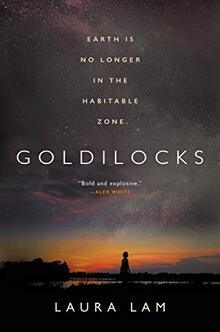 Goldilocks
by Laura Lam (May 2020)
Goldilocks
by Laura Lam (May 2020)
Category: Science Fiction, Thriller
In this gripping science fiction thriller, five women steal a spaceship to ensure the survival of the human race.
Despite increasing restrictions on the freedoms of women on Earth, Captain Valerie Black is spearheading the first all-female mission to a planet in the Goldilocks Zone, where conditions are just right for human habitation.
It's humanity's last hope for survival. But when things start going wrong on the ship, Naomi, the crew’s botanist, begins to suspect that someone on board is concealing a terrible secret - and realizes time for life on Earth may be running out faster than they feared.
Goldilocks is The Handmaid's Tale meets The Martian - a bold and thought-provoking new high-concept thriller.
I just finished this book, and it certainly kept my attention. But the rub comes from the comparisons in the paragraph above. While it was above average, both The Handmaid's Tale and The Martian were superb. I'd recommend you pick those two up and read them instead if you haven't. If you've already read them and liked them, then try Goldilocks also. It's certainly worth your time, and it's a fast read.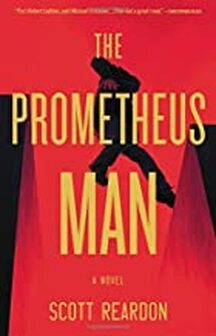 Prometheus Man
(Book 1)
Prometheus Man
(Book 1)
by Scott Reardon (2017)
Category: Thriller
This book is on my list because it's the first book of a continuing series. While the blurb says the second book can be read alone, well, color me doubtful.
When a pile of bodies is found in Paris, CIA Agent Tom Blake hustles his way onto a major case: tracking a man with enhanced abilities, the test subject of a secret government program. There's just one problem: the man using Agent Blake's identity is not Agent Blake. He's Tom Reese, a man without a family or a home.
Reese is searching for his brother's killer. He stole Agent Blake's identity two months ago and has bluffed his way onto the team investigating his only lead. But his time as a CIA agent is accelerating toward its expiration date. Soon the CIA will find out that Agent Blake is in two places at once. Soon the augmented man will come looking for him. And soon both will discover that Tom Reese carries a secret even he doesn't know about: He is the last test subject of Project Prometheus.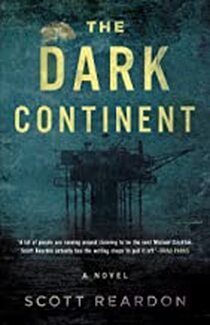 The Dark Continent
(Book 2)
The Dark Continent
(Book 2)
by Scott Reardon (2020)
Category: Thriller
Looking at the covers, one would have no idea this was a continuing series. I like this cover SO much better!
On an oil rig off the coast of Alaska, fifteen test subjects, all of them death-row inmates, have joined a gruesome experiment with unprecedented implications.
Government researchers are attempting to enhance the human body, but they change the men into something else instead. Led by a mysterious figure who evokes Colonel Kurtz and Satan from Paradise Lost, the subjects escape and bring the United States to its knees.
Only two men can stop them, Tom Reese and Karl Lyons. Tom and Karl will have to cross an America on the brink of collapse. And at the end they’ll experience the horror of the dark continent. The Maddaddam Trilogy
The Maddaddam Trilogy
by Margaret Atwood
Category: Dystopian
I loved The Handmaid's Tale, so I'm dipping my toe again in Atwood's dystopian pool for this trilogy.
Across three stunning novels--Oryx and Crake, The Year of the Flood, and Maddaddam—Atwood projects us into a near future that is both all too familiar and beyond our imagining.
In Oryx and Crake (Book 1, 2003), a man struggles to survive in a world where he may be the last human. In search of answers, he embarks on a journey through the lush wilderness that was so recently a great city, until powerful corporations took mankind on an uncontrolled genetic engineering ride.
In The Year of the Flood (Book 2, 2009) the long-feared waterless flood has occurred, altering Earth as we know it and obliterating most human life.
And in Maddaddam (Book 3, 2013) a small group of survivors band together with the Children of Crake: the gentle, bioengineered quasi-human species who will inherit this new earth.
Set in a darkly plausible future shaped by plagues, floods, and genetic engineering, these three novels take us from the end of the world to a brave new beginning. I can’t wait to see where this amazing author takes me!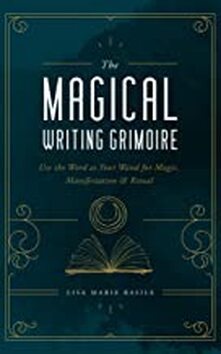 The Magical Writing Grimoire
The Magical Writing Grimoire
by Lisa Marie Masile (2020)
Category: Wicca, Spiritual
This book combines two of my greatest loves: Magic and writing. I'm half-way through, and have a lot of sticky notes with reminders to go back and try sigils, the waning moon ritual, and several others.
Part guided journaling practice, part interactive magical grimoire, The Magical Writing Grimoire shows how to incorporate writing as a magical tool to create healing and amplify spell-casting.
During times of chaos or pain, or simply when you need a cosmic boost, writing can help. In fact, healers, therapists, and magical practitioners have long incorporated writing in their practices. From letter writing for creating closure to dream diaries, writing is a powerful process for moving your dreams into manifestation.
The book approaches writing as a self-actualizing, intentional, and healing act and shows how to combine writing with ritual and magic for self- discovery, clarifying intentions, creating and making things happen, and manifestation.
It also instructs how to create a personal grimoire. Each chapter contains writing prompts that also incorporate magical ritual and tools including working with crystals, spell incantation, or candle alchemy.
Equal parts practical and inspiring, The Magical Writing Grimoire shows you how to wield your word as your wand.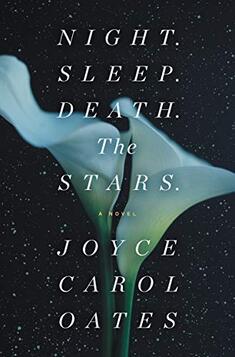 Night. Sleep. Death. Stars
Night. Sleep. Death. Stars
by Joyce Carol Oats (release date June 2020)
Category: General Fiction, Literary
I’ve been reading this author since before I was old enough to read adult books (yes, my mother was lenient about some things). Over her prodigious career, Oats has created enough characters to populate several small towns, and no two have been alike.
Now in her 80s, Oats adopts this unusual title from a line in a poem by Walt Whitman.
The book is a massive (800 page) masterpiece on grief and its effect on a widow and her five children.
It begins with the sudden death of a family patriarch. Whitey stopped to help prevent a brutal crime and instead became the next victim.
The author skillfully cuts open and examines each character. The black hearts of these children, and others, are exposed as only Joyce Carol Oats can do. In other hands, this examination could make the book feel padded. But she manages to make every page necessary. Be prepared for a disturbing and emotional journey.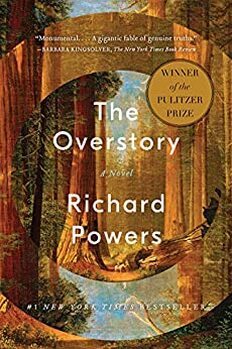 The Overstory
The Overstory
by Richard Powers (2018)
2019 Pulitzer Prize in Fiction
Environmental Fiction (I made that category up),
Spiritual
Do you know and love trees? I thought I did until I read this book. Now I realize I have so much more to learn.
The book is described as a sweeping, impassioned work of activism and resistance that is also a stunning evocation of—and paean to—the natural world. From the roots to the crown and back to the seeds, Richard Powers’ twelfth novel unfolds in concentric rings of interlocking fables that range from antebellum New York to the late twentieth-century Timber Wars of the Pacific Northwest and beyond.
There is a world alongside ours—vast, slow, interconnected, resourceful, magnificently inventive, and almost invisible to us. This is the story of a handful of people who learn how to see that world and who are drawn up into its unfolding catastrophe.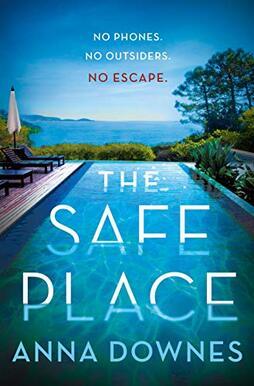 The Safe Place
The Safe Place
by Anna Downes (Release July 14, 2020)
Category: Suspense
Emily Proudman just lost her acting agent, her job, and her apartment in one miserable day. She’s desperate.
Scott Denny, a successful and charismatic CEO, has a problem that neither his business acumen nor vast wealth can fix. Until he meets Emily.
Emily is perfect.
Scott offers Emily a summer job as a housekeeper on his remote, beautiful French estate. Enchanted by his lovely wife Nina, and his eccentric young daughter, Aurelia, Emily falls headlong into this oasis of wine-soaked days by the pool. But soon she realizes that Scott and Nina are hiding dangerous secrets, and if she doesn't play along, the consequences could be deadly.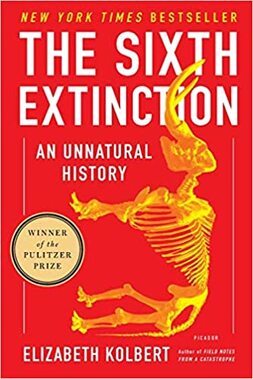 The Sixth Extinction
The Sixth Extinction
by Elizabeth Kolbert ( 2014)
Category: Non-fiction
Pulitzer Prize Winner
A major book about the future of the world, blending intellectual and natural history and field reporting into a powerful account of the mass extinction unfolding before our eyes
Over the last half-billion years, there have been Five mass extinctions, when the diversity of life on earth suddenly and dramatically contracted. These mass extinctions and their probable causes: End-Ordovician, glaciation; Late Devonian, volcanism; End-Permian, the warming of the oceans, the proliferation of a bacteria that produced hydrogen sulfide, and a consequent greenhouse effect; Late Triassic, ocean acidification; and End-Cretaceous, a gigantic meteor collides with the earth.
So, what’s the sixth extinction and why is it different? The causes of the five previous mass extinction were natural catastrophes. The sixth, in contrast, is man-made. And it’s occurring now.
New Yorker writer Elizabeth Kolbert tells us why and how human beings have altered life on the planet in a way no species has before.
Interweaving research in half a dozen disciplines, descriptions of the fascinating species that have already been lost, and the history of extinction as a concept, Kolbert provides a moving and comprehensive account of the disappearances occurring before our very eyes, and the staggering fact that we’re facing extinction of 20 to 50 percent of all species on Earth within this century.
Kolbert explains, in elegant, accessible prose: sea levels rising, deforestation, the dispersion of disease-carrying species. But she also digs deep, offering an intellectual history of “extinction” and placing in context the catastrophes ahead by grappling with how life on Earth ended and was regenerated in the distant past.
“The Sixth Extinction is a wonderful book, and it makes very clear that big, abrupt changes can happen; they're not outside the realm of possibility. They have happened before, they can happen again.” ―President Barack Obama
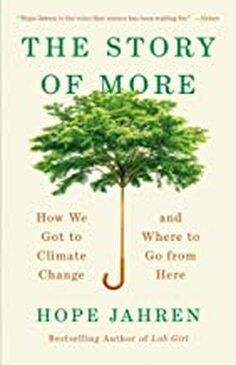 The Story of More
The Story of More
By Hope Jahran (March 2020)
Category: Non-fiction
Hope Jahren is an award-winning scientist, a brilliant writer, and a passionate teacher. In The Story of More, she illuminates the link between human habits and our imperiled planet. In concise, highly readable chapters, she takes us through the science behind the key inventions—from electric power to large-scale farming to automobiles—that, even as they help us, release greenhouse gases into the atmosphere like never before. She explains the current and projected consequences of global warming—from superstorms to rising sea levels—and the actions that we all can take to fight back.
At once an explainer on the mechanisms of global change and a lively, personal narrative given to us in Jahren’s inimitable voice, The Story of More is the essential pocket primer on climate change that will leave an indelible impact on everyone who reads it.
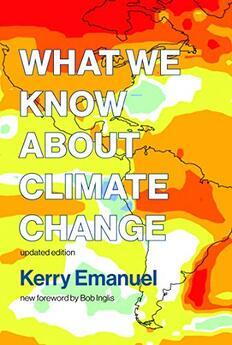 What We Know About Climate Change
What We Know About Climate Change
by Kerry Emanuel (2018)
Category: Non-fiction
An M.I.T. climatologist and a conservative, Emanuel sounds the alarm in a measured and scientifically sound way, making clear what we know and what we don’t know. There is little panic in this slender book, but there is a lot of troubling information.
The vast majority of scientists agree that human activity has significantly increased greenhouse gases in the atmosphere—most dramatically since the 1970s. Yet global warming skeptics and ill-informed elected officials continue to dismiss this broad scientific consensus.
Emanuel specifically thought of his book as a way of offering ammunition to those trying to convince family members or friends who are skeptical or don’t understand the science.
“Young adults who are disputing this problem with their own parents or an uncle or something — they can hand the book to them and say, ‘Will you at least read this?’” Emanuel said in a 2013 interview with The Times. “One at a time, you might change minds.”
Emanuel outlines the basic science of global warming and how the current consensus has emerged. Although it is impossible to predict exactly when the most dramatic effects of global warming will be felt, he argues, we can be confident that we face real dangers. Emanuel warns that global warming will contribute to an increase in the intensity and power of hurricanes and flooding and more rapidly advancing deserts. But just as our actions have created the looming crisis, so too might they avert it. Emanuel calls for urgent action to reduce greenhouse gases and criticizes the media for downplaying the dangers of global warming (and, in search of “balance,” quoting extremists who deny its existence).
This edition has been updated to include the latest climate data, a discussion of the earth's carbon cycle, the warming hiatus of the first decade of this century, the 2017 hurricanes, advanced energy options, the withdrawal from the Paris climate agreement, and more. It offers a new foreword by former U.S. Representative Bob Inglis (R-SC), who now works on climate action through his organization.
So, there you have my eclectic reading plans for the summer.
Please let me know which titles ignite your interest!
Or, feel free to suggest your favorite books from 2019-2020. I'll consider adding them to my reading list.
Namaste friends. Good reading!
Here is my list for the remainder of 2020--although I'm sure Netgalley will tempt me with some new fall titles soon.
I would love to hear from you! If one of these 16 books look like something you'd like to read, drop me a post reply and I'll post a full-length review later. If I don't love it or recommend after reading, I'll let you know that as well.
Happy reading~
 The Bear by Andrew Krivak (2020)
The Bear by Andrew Krivak (2020)Category: Literary Fiction
I just finished this sweet story. It was perfect for these scary, uncertain times. Very earth and nature-based, but not hokey. "Thumbs up."
In an Eden-like future, a girl and her father live close to the land in the shadow of a lone mountain. They possess a few remnants of civilization: some books, a pane of glass, a set of flint and steel, a comb. The father teaches the girl how to fish and hunt, the secrets of the seasons and the stars. He is preparing her for an adulthood in harmony with nature, for they are the last of humankind.
But when the girl finds herself alone in an unknown landscape, it is a bear that will lead her back home through a vast wilderness that offers the greatest lessons of all, if she can only learn to listen.
A cautionary tale of human fragility, of love and loss, The Bear is a stunning tribute to the beauty of nature’s dominion.
Krivak delivers a transcendent journey into a world where all living things—humans, animals, trees—coexist in magical balance, forever telling each other’s unique stories. This beautiful and elegant novel is a gem.”
 Blood Victory
by Christopher Rice (publication date: August 18, 2020)
Blood Victory
by Christopher Rice (publication date: August 18, 2020)Category: Thriller, Horror
This is the 3rd book in the Burning Girl series (I’ve already enjoyed and reviewed Bone Music and Blood Echo).
The background: As the test subject of an experimental drug, Charlotte Rowe was infused with extraordinary powers. As the secret weapon of a mysterious consortium, she baits evil predators and stops them in their tracks. But it takes more than fear to trigger what’s coursing through Charlotte’s blood. She needs to be terrorized.
In this book, serial killer Cyrus Mattingly is up to the task.
Cyrus is a long-haul truck driver, and his cargo bay is a gallery of horrors on wheels. To stop his bloodshed, Charlotte will become his next victim, reining in her powers so she can face each of his evils in turn.
As much as they know about Cyrus—his method of selecting victims, his prolonged rituals—there is something they don’t. What happens on the dark and lonely highways is only the journey. It’s the destination that’s truly depraved. Before she can unleash vengeance on a scale this killer has never seen, Charlotte and her team will have to go the distance into hell.
 Cloud Warriors
by Rob Jung (2019)
Cloud Warriors
by Rob Jung (2019)Category: Medical Thriller
Anthropology professor Terry Castro, leading a summer-school program in the Peruvian rain forest, stumbles upon the remnant of a nation of tall, white-skinned warriors from the time of the Incan empire. But, when a simple accident leaves Castro poisoned, a series of events are set in motion that threaten his life, and the extinction of the tribe.
With the help of a young medium, Carrie Waters, Castro tries to find a remedy and discovers the poison also has the capability of tripling life expectancy. Waters confides in her uncle, Vikter Glass, a pharmaceutical company executive, in the hope that the company can manufacture an antidote.
Her innocent attempt to save the man she loves triggers a race to locate the lost tribe and its fountain-of-youth elixir. Scientific advancement collides with corporate greed as competing forces converge on the tribe. The ensuing battle leaves the survivors asking: might extending human life expectancy destroy society as we know it?
Interesting tidbit: Author Robert Jung earned his law degree at Harvard Law School. He’s described by a friend as a Renaissance man. He published his first novel at age seventy-five. Since this one was published in Feb. 2019, he’s put out two more!
 he Fox
by Frederick Forsyth (2018)
he Fox
by Frederick Forsyth (2018)Category: Techno Thriller, International Thriller
A New York Times-bestselling master of international intrigue takes us into the bleeding-edge world of technological espionage that feels chillingly real.
Former chief of the British Secret Intelligence Service Adrian Weston is awoken in the middle of the night by a phone call from the Prime Minister. Her news is shocking: the Pentagon, the NSA, and the CIA have been hacked simultaneously, their seemingly impenetrable firewalls breached by an unknown enemy known only as "The Fox."
Surprisingly, the culprit is revealed to be a young British teenager, Luke Jennings. He has no agenda, no secrets, just a blisteringly brilliant mind and a drive to break code. Extradition to the U.S. seems likely--until Weston has another idea: If Luke can do this to us, what can he do to our enemies?
After conferring with both the American President and the Prime Minister, Weston is determined to use "The Fox" and his talents to the advantage of the two nations. But doing so places the boy on a geopolitical minefield. Adrian must stay one step ahead of multiple invisible enemies, all while finding a way to utilize the most powerful--and most unpredictable--weapon of all.
With his trademark research and deep knowledge of the rules and practices of international intrigue, Forsyth takes on tomorrow's threats in this race-against-the-clock thriller.
Forsyth, at age 80, has published 17 books. In case you can’t place the name, Forsyth published his first novel, The Day of the Jackal—a plot to assassinate French President Charles de Gaulle--in 1971.
His grasp of current global politics is still spot on.
 Goldilocks
by Laura Lam (May 2020)
Goldilocks
by Laura Lam (May 2020)Category: Science Fiction, Thriller
In this gripping science fiction thriller, five women steal a spaceship to ensure the survival of the human race.
Despite increasing restrictions on the freedoms of women on Earth, Captain Valerie Black is spearheading the first all-female mission to a planet in the Goldilocks Zone, where conditions are just right for human habitation.
It's humanity's last hope for survival. But when things start going wrong on the ship, Naomi, the crew’s botanist, begins to suspect that someone on board is concealing a terrible secret - and realizes time for life on Earth may be running out faster than they feared.
Goldilocks is The Handmaid's Tale meets The Martian - a bold and thought-provoking new high-concept thriller.
I just finished this book, and it certainly kept my attention. But the rub comes from the comparisons in the paragraph above. While it was above average, both The Handmaid's Tale and The Martian were superb. I'd recommend you pick those two up and read them instead if you haven't. If you've already read them and liked them, then try Goldilocks also. It's certainly worth your time, and it's a fast read.
 Prometheus Man
(Book 1)
Prometheus Man
(Book 1)by Scott Reardon (2017)
Category: Thriller
This book is on my list because it's the first book of a continuing series. While the blurb says the second book can be read alone, well, color me doubtful.
When a pile of bodies is found in Paris, CIA Agent Tom Blake hustles his way onto a major case: tracking a man with enhanced abilities, the test subject of a secret government program. There's just one problem: the man using Agent Blake's identity is not Agent Blake. He's Tom Reese, a man without a family or a home.
Reese is searching for his brother's killer. He stole Agent Blake's identity two months ago and has bluffed his way onto the team investigating his only lead. But his time as a CIA agent is accelerating toward its expiration date. Soon the CIA will find out that Agent Blake is in two places at once. Soon the augmented man will come looking for him. And soon both will discover that Tom Reese carries a secret even he doesn't know about: He is the last test subject of Project Prometheus.
 The Dark Continent
(Book 2)
The Dark Continent
(Book 2)by Scott Reardon (2020)
Category: Thriller
Looking at the covers, one would have no idea this was a continuing series. I like this cover SO much better!
On an oil rig off the coast of Alaska, fifteen test subjects, all of them death-row inmates, have joined a gruesome experiment with unprecedented implications.
Government researchers are attempting to enhance the human body, but they change the men into something else instead. Led by a mysterious figure who evokes Colonel Kurtz and Satan from Paradise Lost, the subjects escape and bring the United States to its knees.
Only two men can stop them, Tom Reese and Karl Lyons. Tom and Karl will have to cross an America on the brink of collapse. And at the end they’ll experience the horror of the dark continent.
 The Maddaddam Trilogy
The Maddaddam Trilogy
by Margaret Atwood
Category: Dystopian
I loved The Handmaid's Tale, so I'm dipping my toe again in Atwood's dystopian pool for this trilogy.
Across three stunning novels--Oryx and Crake, The Year of the Flood, and Maddaddam—Atwood projects us into a near future that is both all too familiar and beyond our imagining.
In Oryx and Crake (Book 1, 2003), a man struggles to survive in a world where he may be the last human. In search of answers, he embarks on a journey through the lush wilderness that was so recently a great city, until powerful corporations took mankind on an uncontrolled genetic engineering ride.
In The Year of the Flood (Book 2, 2009) the long-feared waterless flood has occurred, altering Earth as we know it and obliterating most human life.
And in Maddaddam (Book 3, 2013) a small group of survivors band together with the Children of Crake: the gentle, bioengineered quasi-human species who will inherit this new earth.
Set in a darkly plausible future shaped by plagues, floods, and genetic engineering, these three novels take us from the end of the world to a brave new beginning. I can’t wait to see where this amazing author takes me!
 The Magical Writing Grimoire
The Magical Writing Grimoire
by Lisa Marie Masile (2020)
Category: Wicca, Spiritual
This book combines two of my greatest loves: Magic and writing. I'm half-way through, and have a lot of sticky notes with reminders to go back and try sigils, the waning moon ritual, and several others.
Part guided journaling practice, part interactive magical grimoire, The Magical Writing Grimoire shows how to incorporate writing as a magical tool to create healing and amplify spell-casting.
During times of chaos or pain, or simply when you need a cosmic boost, writing can help. In fact, healers, therapists, and magical practitioners have long incorporated writing in their practices. From letter writing for creating closure to dream diaries, writing is a powerful process for moving your dreams into manifestation.
The book approaches writing as a self-actualizing, intentional, and healing act and shows how to combine writing with ritual and magic for self- discovery, clarifying intentions, creating and making things happen, and manifestation.
It also instructs how to create a personal grimoire. Each chapter contains writing prompts that also incorporate magical ritual and tools including working with crystals, spell incantation, or candle alchemy.
Equal parts practical and inspiring, The Magical Writing Grimoire shows you how to wield your word as your wand.
 Night. Sleep. Death. Stars
Night. Sleep. Death. Stars
by Joyce Carol Oats (release date June 2020)
Category: General Fiction, Literary
I’ve been reading this author since before I was old enough to read adult books (yes, my mother was lenient about some things). Over her prodigious career, Oats has created enough characters to populate several small towns, and no two have been alike.
Now in her 80s, Oats adopts this unusual title from a line in a poem by Walt Whitman.
The book is a massive (800 page) masterpiece on grief and its effect on a widow and her five children.
It begins with the sudden death of a family patriarch. Whitey stopped to help prevent a brutal crime and instead became the next victim.
The author skillfully cuts open and examines each character. The black hearts of these children, and others, are exposed as only Joyce Carol Oats can do. In other hands, this examination could make the book feel padded. But she manages to make every page necessary. Be prepared for a disturbing and emotional journey.
 The Overstory
The Overstory
by Richard Powers (2018)
2019 Pulitzer Prize in Fiction
Environmental Fiction (I made that category up),
Spiritual
Do you know and love trees? I thought I did until I read this book. Now I realize I have so much more to learn.
The book is described as a sweeping, impassioned work of activism and resistance that is also a stunning evocation of—and paean to—the natural world. From the roots to the crown and back to the seeds, Richard Powers’ twelfth novel unfolds in concentric rings of interlocking fables that range from antebellum New York to the late twentieth-century Timber Wars of the Pacific Northwest and beyond.
There is a world alongside ours—vast, slow, interconnected, resourceful, magnificently inventive, and almost invisible to us. This is the story of a handful of people who learn how to see that world and who are drawn up into its unfolding catastrophe.
 The Safe Place
The Safe Place
by Anna Downes (Release July 14, 2020)
Category: Suspense
Emily Proudman just lost her acting agent, her job, and her apartment in one miserable day. She’s desperate.
Scott Denny, a successful and charismatic CEO, has a problem that neither his business acumen nor vast wealth can fix. Until he meets Emily.
Emily is perfect.
Scott offers Emily a summer job as a housekeeper on his remote, beautiful French estate. Enchanted by his lovely wife Nina, and his eccentric young daughter, Aurelia, Emily falls headlong into this oasis of wine-soaked days by the pool. But soon she realizes that Scott and Nina are hiding dangerous secrets, and if she doesn't play along, the consequences could be deadly.
 The Sixth Extinction
The Sixth Extinction by Elizabeth Kolbert ( 2014)
Category: Non-fiction
Pulitzer Prize Winner
A major book about the future of the world, blending intellectual and natural history and field reporting into a powerful account of the mass extinction unfolding before our eyes
Over the last half-billion years, there have been Five mass extinctions, when the diversity of life on earth suddenly and dramatically contracted. These mass extinctions and their probable causes: End-Ordovician, glaciation; Late Devonian, volcanism; End-Permian, the warming of the oceans, the proliferation of a bacteria that produced hydrogen sulfide, and a consequent greenhouse effect; Late Triassic, ocean acidification; and End-Cretaceous, a gigantic meteor collides with the earth.
So, what’s the sixth extinction and why is it different? The causes of the five previous mass extinction were natural catastrophes. The sixth, in contrast, is man-made. And it’s occurring now.
New Yorker writer Elizabeth Kolbert tells us why and how human beings have altered life on the planet in a way no species has before.
Interweaving research in half a dozen disciplines, descriptions of the fascinating species that have already been lost, and the history of extinction as a concept, Kolbert provides a moving and comprehensive account of the disappearances occurring before our very eyes, and the staggering fact that we’re facing extinction of 20 to 50 percent of all species on Earth within this century.
Kolbert explains, in elegant, accessible prose: sea levels rising, deforestation, the dispersion of disease-carrying species. But she also digs deep, offering an intellectual history of “extinction” and placing in context the catastrophes ahead by grappling with how life on Earth ended and was regenerated in the distant past.
“The Sixth Extinction is a wonderful book, and it makes very clear that big, abrupt changes can happen; they're not outside the realm of possibility. They have happened before, they can happen again.” ―President Barack Obama
 The Story of More
The Story of MoreBy Hope Jahran (March 2020)
Category: Non-fiction
Hope Jahren is an award-winning scientist, a brilliant writer, and a passionate teacher. In The Story of More, she illuminates the link between human habits and our imperiled planet. In concise, highly readable chapters, she takes us through the science behind the key inventions—from electric power to large-scale farming to automobiles—that, even as they help us, release greenhouse gases into the atmosphere like never before. She explains the current and projected consequences of global warming—from superstorms to rising sea levels—and the actions that we all can take to fight back.
At once an explainer on the mechanisms of global change and a lively, personal narrative given to us in Jahren’s inimitable voice, The Story of More is the essential pocket primer on climate change that will leave an indelible impact on everyone who reads it.
 What We Know About Climate Change
What We Know About Climate Changeby Kerry Emanuel (2018)
Category: Non-fiction
An M.I.T. climatologist and a conservative, Emanuel sounds the alarm in a measured and scientifically sound way, making clear what we know and what we don’t know. There is little panic in this slender book, but there is a lot of troubling information.
The vast majority of scientists agree that human activity has significantly increased greenhouse gases in the atmosphere—most dramatically since the 1970s. Yet global warming skeptics and ill-informed elected officials continue to dismiss this broad scientific consensus.
Emanuel specifically thought of his book as a way of offering ammunition to those trying to convince family members or friends who are skeptical or don’t understand the science.
“Young adults who are disputing this problem with their own parents or an uncle or something — they can hand the book to them and say, ‘Will you at least read this?’” Emanuel said in a 2013 interview with The Times. “One at a time, you might change minds.”
Emanuel outlines the basic science of global warming and how the current consensus has emerged. Although it is impossible to predict exactly when the most dramatic effects of global warming will be felt, he argues, we can be confident that we face real dangers. Emanuel warns that global warming will contribute to an increase in the intensity and power of hurricanes and flooding and more rapidly advancing deserts. But just as our actions have created the looming crisis, so too might they avert it. Emanuel calls for urgent action to reduce greenhouse gases and criticizes the media for downplaying the dangers of global warming (and, in search of “balance,” quoting extremists who deny its existence).
This edition has been updated to include the latest climate data, a discussion of the earth's carbon cycle, the warming hiatus of the first decade of this century, the 2017 hurricanes, advanced energy options, the withdrawal from the Paris climate agreement, and more. It offers a new foreword by former U.S. Representative Bob Inglis (R-SC), who now works on climate action through his organization.
So, there you have my eclectic reading plans for the summer.
Please let me know which titles ignite your interest!
Or, feel free to suggest your favorite books from 2019-2020. I'll consider adding them to my reading list.
Namaste friends. Good reading!
Published on May 05, 2020 18:07
April 23, 2020
Walking for Exercise
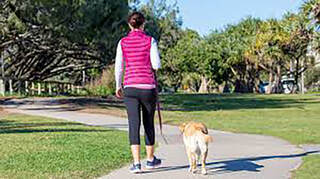 Last week I talked about the health benefits of walking.
Last week I talked about the health benefits of walking.But walking isn’t the perfect exercise. Why? Because most people just walk. They do the same thing day after day, which usually means a comfortable pace following the same route every time.
The result of all this sameness is that you get bored, both mind and body. Walking is cardio exercise that makes our heart and lungs stronger, but it does little, if anything, for your muscle strength. That’s why the American College of Sports Medicine recommends that all adults also strength train least twice a week. And strength training, combined with walking, boosts your results in both activities. Depending on what your personal goals are, strength training may be just as important for you, especially if you want to firm up, and keep your metabolism revved up.
 I attempted to do 30 straight days of yoga in February, following a 40-minute routine on Roku. I loved it. It helped me calm and focus, and I was surprised by how much it helped me strengthen my abdomen in addition to stretching. But I was not able to establish my practice as a routine to do for the rest of my life. Two people in my group have been successful—they’re at 90+ days now. And I’m now determined to incorporate yoga practice into my life, but it can’t be my only exercise.
I attempted to do 30 straight days of yoga in February, following a 40-minute routine on Roku. I loved it. It helped me calm and focus, and I was surprised by how much it helped me strengthen my abdomen in addition to stretching. But I was not able to establish my practice as a routine to do for the rest of my life. Two people in my group have been successful—they’re at 90+ days now. And I’m now determined to incorporate yoga practice into my life, but it can’t be my only exercise.So this month I’m back to walking every day, but with a more structured approach. I’ve laid out my personal walking routine below.
 I use a Fitbit to track my steps. My son uses an Apple watch. My husband prefers to carry his phone and use the MapMyWalk app. There are others, just do a little searching on your phone and find one. Or, you can simply pick a route and do a “walk test” using your car odometer to gauge the distance.
I use a Fitbit to track my steps. My son uses an Apple watch. My husband prefers to carry his phone and use the MapMyWalk app. There are others, just do a little searching on your phone and find one. Or, you can simply pick a route and do a “walk test” using your car odometer to gauge the distance.You’re also going to want to do a walk test. One of the best ways to stay motivated is to see your progress, and to do so, you need a baseline. So, before you start the program, clock yourself to see how quickly you are currently walking. Then, you can retest yourself every 3 weeks to see your progress. To test, walk a mile (or whatever distance you pre-select) as quickly as possible, while still being able to talk (you shouldn’t be gasping for air). When you’ve completed, note your time. Save it so you can compare your progress every 3 weeks.
There is research showing that a.m. exercisers are more likely to stick with an exercise program compared with those who exercise at other times of the day. But honestly, the best time for you to exercise is the time when you’re most likely to do it. For some, that will be early morning. For others, it may be 10 pm.
 For variation, come up with a least three places or routes where you can walk.
For variation, come up with a least three places or routes where you can walk. If you can use a secluded hiking trail, that’s great. But many neighborhoods have walking trails, greenbelts between homes, or parks. Try them all and re-use your favorites. Personal Walking Routine
Week 1 starts at 30-30 minutes five days a week, with two days of strength training (that’s where the yoga moves will come in for me).
I also included week 2 and 3 for you. Please note: If this ramp-up is too fast for you, repeat each week as many times as you want before going to the next stage.
For each walk, begin with 5 minutes of easy walking to warm up. You’re not going to be ambling during these walks, and your muscles need more blood flow and oxygen when you pick up the pace. A warmup eases your body into energetic walking.
WEEK 1
3 days a week – Moderate walk. 3-minute warm-up. 35-minutes going at a purposeful pace and exerting some effort, but still able to talk in complete sentences. 2-minute cooldown at a leisurely pace. (40 minutes total)
2 days a week – Brisk walk. 3 minute warm-up. 25 minutes pick up pace to a brisk walk, like you’re in a hurry but not jogging. 2-minute cooldown. (30 minutes total)
2 days a week – strength training or yoga.
Building muscle strength is key if you want to keep moving and be at your best as you get older. Strength and muscle mass peak in your twenties and start to decline by your forties, getting progressively worse as you age, and making seemingly simple tasks like getting up from a deep chair or climbing stairs more difficult. But muscle decline doesn’t have to be an inevitable part of getting old. Do this routine twice a week, allowing at least 1 day between workouts. Recovery time is key!
Exercises for Strength Training Days
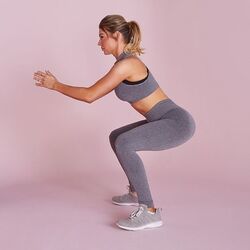 1. Squat
1. SquatSquats are the gold standard of your butt and leg workouts. They’re great for your booty, but they strengthen pretty much every muscle in your lower body, including thighs, core, calves, glutes, hamstrings, and abs.
*Stand with your feet shoulder width apart, toes straight ahead.
*Bend your knees and hinge forward from your hips, lowering yourself as if you are sitting back into a chair.
*Stick your butt out, shift your weight into your heels, and raise your arms out in front of you as you bend your knees and lower as far as possible while maintaining good form. Stop before your hips are in line with your knees.
*Hold for a count of 10.
*Lower back to standing.
Complete 10 reps for a set.
 2. Bent Over Row
2. Bent Over Row Get ready to feel this in your upper back.
*Lean forward and bend both knees, remembering to keep a flat back.
*Extend your arms so they are straight. Lift the dumbbells straight up to chest level, squeezing your shoulder blades together as you do. Be sure to keep your elbows in and pointed upward. Don't arch your back.
*Slowly lower the weights back to the starting position to complete one rep.
Complete 10 reps for a set.
 3. Overhead Triceps Extensions Here's a move you probably know and love that'll target the backs of the arms.
3. Overhead Triceps Extensions Here's a move you probably know and love that'll target the backs of the arms.*Stand with your feet hip distance apart.
*Hold one dumbbell (go for your heavier weight) with both hands, bending the elbows behind your head.
*Straighten your arms to lift the dumbbell into the air, then slowly bend the arms to lower. This counts as one rep.
Complete 10 reps for a set.
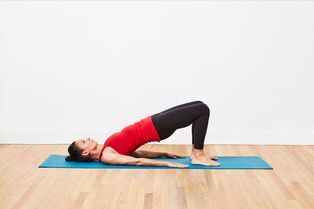 4. Bridge
4. Bridge*Lie on the floor on your back with your legs bent and your feet flat on the floor.
*Place your arms at your sides.
*Contract your abdominals and butt, and lift your hips and back off the floor so your body is in line from your shoulders to your knees.
Hold for a count of 10. Slowly lower.
Complete 10 reps for a set.
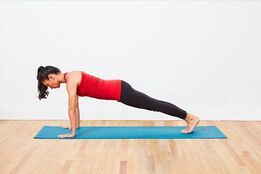 5. Plank
5. Plank *Plant hands directly under shoulders (slightly wider than shoulder width) like you’re about to do a pushup.
*Ground toes into the floor and squeeze glutes to stabilize your body. Your legs should be working, too — be careful not to lock or hyperextend your knees.
*Engage your core by imagining your belly button pulling in toward your spine
*Neutralize your neck and spine by looking at a spot on the floor about a foot beyond your hands. Your head should be in line with your back.
*Hold the position for 20 seconds. As you get more comfortable with the move, hold your plank for as long as possible without compromising your form or breath.
 *NOTE: If the above position is too difficult, bend your arms and rest on your forearms instead.
*NOTE: If the above position is too difficult, bend your arms and rest on your forearms instead.WEEK 2
3 days a week – Moderate walk but increase to 50 minutes total
2 days a week – Brisk walk for 40 minutes total
2 days a week – same strength exercises, now two sets of each
WEEK 3
3 days a week – Moderate, increase to 60 minutes total
2 days a week – Brisk, increase to 50 minutes total
2 days a week – strength training, now three sets of each.
If you try this routine, please drop me a note and let me know how it works for you.
I’ll be posting a new routine in 3 weeks, with some fun and challenging variations, so stay tuned. In the meantime, have a good time walking your way to health during these challenging pandemic weeks. And remember to continue to maintain social distancing while walking!
Namaste. Breathe. We'll get through this.
Published on April 23, 2020 17:48
April 7, 2020
Making the Most of Social Distancing
I was super frustrated with myself this week. I have plenty to do. But I’m cooped up in our house with three humans and six pets, and feeling perpetually tired. Ugh. What could I do to get my enthusiasm back?
Suddenly the light came on. I’ve wanted to start running again, and work my way back to the 10k days of my 30’s and 40’s. Granted, I’m now in my mid-60’s. Heavier, creakier. And also diabetic. Never mind, I could start slowly. And take a dog. (Not all three, I’m not completely nuts). By taking it slowly, I mean walking first. Increasing my distance and time. Then run/walking. Finally working up to running a few miles a day. Baby steps, and even if President Trump eliminates the social distancing in May--keep going.
By taking it slowly, I mean walking first. Increasing my distance and time. Then run/walking. Finally working up to running a few miles a day. Baby steps, and even if President Trump eliminates the social distancing in May--keep going.
You’ve probably heard that when it comes to slimming down, running beats walking. When you look at pure numbers, running certainly has an advantage. But the picture isn’t that black and white.
If a runner and walker, who each weigh 150 pounds, go out for a 30-minute run or walk, guess who’s going to burn more calories? Not surprisingly, the runner will—by about 170. If she’s running at a 10-minute-per-mile pace and the walker is striding along at a 15 minute-per-mile pace. Pretty black and white. But here’s the gray.
Can you walk out the door today and run at a 10-minute-per-mile pace for 30 minutes? Can you do this every day without any joint problems? If so, great! You’re probably already an avid runner. You’ll only want to walk on the days between runs, to allow your body to recover from the higher impact.
But if you, like me, don’t fit the example above today, and you want to burn the same number of calories, we have walking options. And – poof – the world has suddenly given us enough time to walk. You can walk for an hour a day. Or, you can pick up your pace to 4.5 mph (a 13:15 minute-per-mile pace), and you’ll be done in 42 minutes. Push it to 5mph (a 12-minute-per-mile pace), and you just have to go 6 minutes longer than the runner. Yes, that’s a speedy pace, but it’s possible if you work at it.
It requires more time to walk instead of run, but the amount of time—and turning your exercise into a daily habit—is probably more doable and more enjoyable than running, at least for those of us who no longer have 20-year-old legs and knees.
15 Reasons to Love Walking
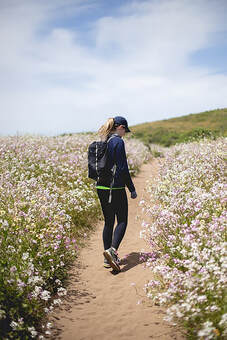 1.
1.
Walking offers instant benefits. You’ll feel happier and calmer. Worries and tension will ease. Cravings will diminish. A new study in the American Journal of Psychiatry suggests that 12% of depression cases could be prevented if we all walked (or did another form of exercise) for at least an hour a week. As you log more miles, your brain releases “happy” chemicals like serotonin and dopamine. This combo of chemicals can lift your mood during and after your workout.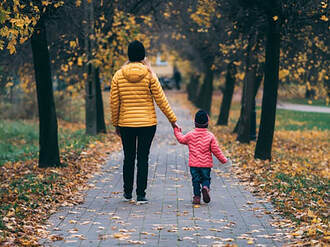 2.
2.
The whole family can do it. One way or another. That includes pushing a stroller if necessary…more calorie burn for the parent!
3. Keep it up and you’ll fall asleep at bedtime—and stay asleep—more easily. 4. Your dogs will love you! Plus, they will be more engaged and will sleep better also.
4. Your dogs will love you! Plus, they will be more engaged and will sleep better also.
5. Walking helps you lose weight. The American Journal of Health Promotion found that women who increased their daily step count by 1,500 steps (about a half-mile mile) lost an average of 2 pounds over nine months. Now, imagine your results if you can hit 10,000 steps (about 6 miles) every day!
 6.
6.
You can exercise outside and soak up the vitamin D and sunshine while still social distancing. A recent study in the Journal of Sport & Psychology confirmed what we all know instinctively: Walking in the fresh air is more enjoyable than slogging around the track in a stuffy gym or stuck on a treadmill.
7.
Body aches and joint pain will subside. Just walking an hour per week acts as lube for creaky joints. Each step moves synovial fluid into and out of our joints and helps circulate nutrients to our cartilage to improve function.
8. Walking improves balance. Especially if you walk in sand or on an uneven surface. And remember to keep your head level and look at the trail ahead of you, not your feet.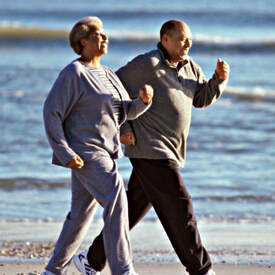 9. If you are at risk for diabetes, walking can help you avoid the disease. Your pancreas, the gland located in your abdomen, produces digestive enzymes and hormones involved in regulating blood sugar. As you’re racking up your steps, your pancreas slows down production of insulin (the hormone that promotes fat storage), which increasing levels of the hormone glucagon. Glucagon pulls sugar out of storage so it can be used as fuel by muscles. If you follow a 30-minute-a-day walking habit, you could lower your diabetes risk by 30%. If you have diabetes (like me), keep walking, because it improves blood sugar control, and can help lower your A1C.
9. If you are at risk for diabetes, walking can help you avoid the disease. Your pancreas, the gland located in your abdomen, produces digestive enzymes and hormones involved in regulating blood sugar. As you’re racking up your steps, your pancreas slows down production of insulin (the hormone that promotes fat storage), which increasing levels of the hormone glucagon. Glucagon pulls sugar out of storage so it can be used as fuel by muscles. If you follow a 30-minute-a-day walking habit, you could lower your diabetes risk by 30%. If you have diabetes (like me), keep walking, because it improves blood sugar control, and can help lower your A1C.
10. Engaging in moderate physical activity, such as a brisk walk, for an hour or more a day may improve neuron health, according to a study in the Journal of Alzheimer’s Disease.
11. It builds stronger bones. Women who walk 4 hours or more a week lower their chances of hip fracture by more than 40%, the landmark Nurses’ Health Study found.
12. Walking strengthens your heart. Regularly walking 3 miles an hour or faster can cut your risk of heart disease by half. Note: Speed matters here. Walking at 2 mph or slower had less beneficial effect.
13. It stimulates your adrenal glands. These small yet powerful hormone producers lie on top of your kidneys and release adrenaline and noradrenaline as part of the fight or flight response that kicks in when you start walking. The hormones signal the heart to beat faster and stronger. As exercise continues and intensity rises, these glands release cortisol. While cortisol has been implicated in the storage of fat when you’re stressed out, under exercise conditions, it prompts the breakdown and release of fat from cells. 14. Phone time is walk time. So put on your sneakers and call a friend. Who says social distancing has to be torture? Make this time of hardship work for you as much as possible.
14. Phone time is walk time. So put on your sneakers and call a friend. Who says social distancing has to be torture? Make this time of hardship work for you as much as possible.
15. Follow the 10-minute rule. On days when you feel like you just can’t, compromise.
Walk for just 10 minutes. Don’t change your clothes, only your shoes. Simply set a time for 10 minutes and start walking. When the time goes off, you’re off the hook. You can stop if you want, without feeling guilty.
The National Weight Control Registry is a database of more than 10,000 people who have lost at least 30 pounds and kept it off for at least a year—but on average, participants have lost 71 pounds and kept it off for 6 years, with some losing as much as 300 pounds. When researchers investigated how these successful losers did it, they found that 94% of them increased physical activity. Guess what type of exercise was reported the most? Yes, walking.
I’m putting together my own daily walking routine, adding some fun variations and speeds to prevent boredom. I’m also charting out strength training routines to incorporate at least twice a week.
I’ll share my routine with you here next week.
Until then, step out for some social distance walking!
Blessed Be.
Suddenly the light came on. I’ve wanted to start running again, and work my way back to the 10k days of my 30’s and 40’s. Granted, I’m now in my mid-60’s. Heavier, creakier. And also diabetic. Never mind, I could start slowly. And take a dog. (Not all three, I’m not completely nuts).
 By taking it slowly, I mean walking first. Increasing my distance and time. Then run/walking. Finally working up to running a few miles a day. Baby steps, and even if President Trump eliminates the social distancing in May--keep going.
By taking it slowly, I mean walking first. Increasing my distance and time. Then run/walking. Finally working up to running a few miles a day. Baby steps, and even if President Trump eliminates the social distancing in May--keep going. You’ve probably heard that when it comes to slimming down, running beats walking. When you look at pure numbers, running certainly has an advantage. But the picture isn’t that black and white.
If a runner and walker, who each weigh 150 pounds, go out for a 30-minute run or walk, guess who’s going to burn more calories? Not surprisingly, the runner will—by about 170. If she’s running at a 10-minute-per-mile pace and the walker is striding along at a 15 minute-per-mile pace. Pretty black and white. But here’s the gray.
Can you walk out the door today and run at a 10-minute-per-mile pace for 30 minutes? Can you do this every day without any joint problems? If so, great! You’re probably already an avid runner. You’ll only want to walk on the days between runs, to allow your body to recover from the higher impact.
But if you, like me, don’t fit the example above today, and you want to burn the same number of calories, we have walking options. And – poof – the world has suddenly given us enough time to walk. You can walk for an hour a day. Or, you can pick up your pace to 4.5 mph (a 13:15 minute-per-mile pace), and you’ll be done in 42 minutes. Push it to 5mph (a 12-minute-per-mile pace), and you just have to go 6 minutes longer than the runner. Yes, that’s a speedy pace, but it’s possible if you work at it.
It requires more time to walk instead of run, but the amount of time—and turning your exercise into a daily habit—is probably more doable and more enjoyable than running, at least for those of us who no longer have 20-year-old legs and knees.
15 Reasons to Love Walking
 1.
1. Walking offers instant benefits. You’ll feel happier and calmer. Worries and tension will ease. Cravings will diminish. A new study in the American Journal of Psychiatry suggests that 12% of depression cases could be prevented if we all walked (or did another form of exercise) for at least an hour a week. As you log more miles, your brain releases “happy” chemicals like serotonin and dopamine. This combo of chemicals can lift your mood during and after your workout.
 2.
2. The whole family can do it. One way or another. That includes pushing a stroller if necessary…more calorie burn for the parent!
3. Keep it up and you’ll fall asleep at bedtime—and stay asleep—more easily.
 4. Your dogs will love you! Plus, they will be more engaged and will sleep better also.
4. Your dogs will love you! Plus, they will be more engaged and will sleep better also.5. Walking helps you lose weight. The American Journal of Health Promotion found that women who increased their daily step count by 1,500 steps (about a half-mile mile) lost an average of 2 pounds over nine months. Now, imagine your results if you can hit 10,000 steps (about 6 miles) every day!
 6.
6.You can exercise outside and soak up the vitamin D and sunshine while still social distancing. A recent study in the Journal of Sport & Psychology confirmed what we all know instinctively: Walking in the fresh air is more enjoyable than slogging around the track in a stuffy gym or stuck on a treadmill.
7.
Body aches and joint pain will subside. Just walking an hour per week acts as lube for creaky joints. Each step moves synovial fluid into and out of our joints and helps circulate nutrients to our cartilage to improve function.
8. Walking improves balance. Especially if you walk in sand or on an uneven surface. And remember to keep your head level and look at the trail ahead of you, not your feet.
 9. If you are at risk for diabetes, walking can help you avoid the disease. Your pancreas, the gland located in your abdomen, produces digestive enzymes and hormones involved in regulating blood sugar. As you’re racking up your steps, your pancreas slows down production of insulin (the hormone that promotes fat storage), which increasing levels of the hormone glucagon. Glucagon pulls sugar out of storage so it can be used as fuel by muscles. If you follow a 30-minute-a-day walking habit, you could lower your diabetes risk by 30%. If you have diabetes (like me), keep walking, because it improves blood sugar control, and can help lower your A1C.
9. If you are at risk for diabetes, walking can help you avoid the disease. Your pancreas, the gland located in your abdomen, produces digestive enzymes and hormones involved in regulating blood sugar. As you’re racking up your steps, your pancreas slows down production of insulin (the hormone that promotes fat storage), which increasing levels of the hormone glucagon. Glucagon pulls sugar out of storage so it can be used as fuel by muscles. If you follow a 30-minute-a-day walking habit, you could lower your diabetes risk by 30%. If you have diabetes (like me), keep walking, because it improves blood sugar control, and can help lower your A1C.10. Engaging in moderate physical activity, such as a brisk walk, for an hour or more a day may improve neuron health, according to a study in the Journal of Alzheimer’s Disease.
11. It builds stronger bones. Women who walk 4 hours or more a week lower their chances of hip fracture by more than 40%, the landmark Nurses’ Health Study found.
12. Walking strengthens your heart. Regularly walking 3 miles an hour or faster can cut your risk of heart disease by half. Note: Speed matters here. Walking at 2 mph or slower had less beneficial effect.
13. It stimulates your adrenal glands. These small yet powerful hormone producers lie on top of your kidneys and release adrenaline and noradrenaline as part of the fight or flight response that kicks in when you start walking. The hormones signal the heart to beat faster and stronger. As exercise continues and intensity rises, these glands release cortisol. While cortisol has been implicated in the storage of fat when you’re stressed out, under exercise conditions, it prompts the breakdown and release of fat from cells.
 14. Phone time is walk time. So put on your sneakers and call a friend. Who says social distancing has to be torture? Make this time of hardship work for you as much as possible.
14. Phone time is walk time. So put on your sneakers and call a friend. Who says social distancing has to be torture? Make this time of hardship work for you as much as possible.15. Follow the 10-minute rule. On days when you feel like you just can’t, compromise.
Walk for just 10 minutes. Don’t change your clothes, only your shoes. Simply set a time for 10 minutes and start walking. When the time goes off, you’re off the hook. You can stop if you want, without feeling guilty.
The National Weight Control Registry is a database of more than 10,000 people who have lost at least 30 pounds and kept it off for at least a year—but on average, participants have lost 71 pounds and kept it off for 6 years, with some losing as much as 300 pounds. When researchers investigated how these successful losers did it, they found that 94% of them increased physical activity. Guess what type of exercise was reported the most? Yes, walking.
I’m putting together my own daily walking routine, adding some fun variations and speeds to prevent boredom. I’m also charting out strength training routines to incorporate at least twice a week.
I’ll share my routine with you here next week.
Until then, step out for some social distance walking!
Blessed Be.
Published on April 07, 2020 19:56
March 25, 2020
Where Do We Go From Here? Thoughts on the Coronavirus Pandemic
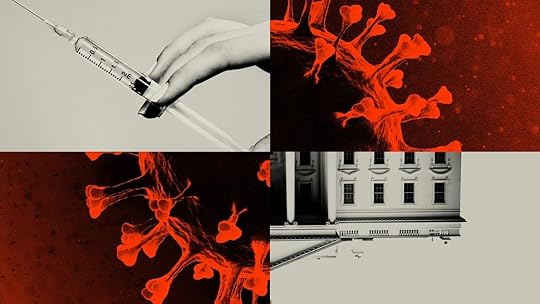 I’ve been reading a lot of articles on the science of this CoV-2 virus and its long-term effects on our world. This article by Ed Yong, science staff writer for The Atlantic Magazine, dated March 25, is, in my opinion, one of the best I’ve read. I took liberties and edited it to update the numbers to today’s results. Please take ten minutes from your busy, shelter-in-place life and read it. Thank you!
I’ve been reading a lot of articles on the science of this CoV-2 virus and its long-term effects on our world. This article by Ed Yong, science staff writer for The Atlantic Magazine, dated March 25, is, in my opinion, one of the best I’ve read. I took liberties and edited it to update the numbers to today’s results. Please take ten minutes from your busy, shelter-in-place life and read it. Thank you!Three months ago, no one knew that SARS-CoV-2 existed. Now the virus has spread to almost every country, infecting at least 446,000 people whom we know about, and many more whom we do not. It has crashed economies and broken health-care systems, filled hospitals and emptied public spaces. It has separated people from their workplaces and their friends. It has disrupted modern society on a scale that most living people have never witnessed. Soon, most everyone in the United States will know someone who has been infected. Like World War II or the 9/11 attacks, this pandemic has already imprinted itself upon the nation’s psyche.
A global pandemic of this scale was inevitable. In recent years, hundreds of health experts have written books, white papers, and op-eds warning of the possibility. Bill Gates has been telling anyone who would listen, including the 18 million viewers of his TED Talk. In 2018, I wrote a story for The Atlantic arguing that America was not ready for the pandemic that would eventually come. In October, the Johns Hopkins Center for Health Security war-gamed what might happen if a new coronavirus swept the globe. And then one did. Hypotheticals became reality. “What if?” became “Now what?”
So, now what? Last Wednesday, which now feels like the distant past, I was talking about the pandemic with a pregnant friend who was days away from her due date. We realized that her child might be one of the first born into a society profoundly altered by COVID-19. We decided to call them Generation C.
Gen C’s lives will be shaped by the choices made in the coming weeks, and by the losses we suffer as a result. But first, a brief reckoning. On the Global Health Security Index, a report card that grades every country on its pandemic preparedness, the United States has a score of 83.5—the world’s highest. Rich, strong, developed, America is supposed to be the readiest of nations. That illusion has been shattered. Despite months of advance warning as the virus spread in other countries, when America was finally tested by COVID-19, it failed.
“No matter what, a virus [like SARS-CoV-2] was going to test the resilience of even the most well-equipped health systems,” says Nahid Bhadelia, an infectious-diseases physician at the Boston University School of Medicine. More transmissible and fatal than seasonal influenza, the new coronavirus is also stealthier, spreading from one host to another for several days before triggering obvious symptoms. To contain such a pathogen, nations must develop a test and use it to identify infected people, isolate them, and trace those they’ve had contact with. That is what South Korea, Singapore, and Hong Kong did to tremendous effect. It is what the United States did not.
As my colleagues Alexis Madrigal and Robinson Meyer have reported, the Centers for Disease Control and Prevention developed and distributed a faulty test in February. Independent labs created alternatives, but were mired in bureaucracy from the FDA. In a crucial month when the American caseload shot into the tens of thousands, only hundreds of people were tested. That a biomedical powerhouse like the U.S. should so thoroughly fail to create a very simple diagnostic test was, quite literally, unimaginable. “I’m not aware of any simulations that I or others have run where we [considered] a failure of testing,” says Alexandra Phelan of Georgetown University, who works on legal and policy issues related to infectious diseases.
The testing fiasco was the original sin of America’s pandemic failure, the single flaw that undermined every other countermeasure. If the country could have accurately tracked the spread of the virus, hospitals could have executed their pandemic plans, girding themselves by allocating treatment rooms, ordering extra supplies, tagging in personnel, or assigning specific facilities to deal with COVID-19 cases. None of that happened. Instead, a health-care system that already runs close to full capacity, and that was already challenged by a severe flu season, was suddenly faced with a virus that had been left to spread, untracked, through communities around the country. Overstretched hospitals became overwhelmed. Basic protective equipment, such as masks, gowns, and gloves, began to run out. Beds will soon follow, as will the ventilators that provide oxygen to patients whose lungs are besieged by the virus.
With little room to surge during a crisis, America’s health-care system operates on the assumption that unaffected states can help beleaguered ones in an emergency. That ethic works for localized disasters such as hurricanes or wildfires, but not for a pandemic that is now in all 50 states. Cooperation has given way to competition; some worried hospitals have bought out large quantities of supplies, in the way that panicked consumers have bought out toilet paper.
Partly, that’s because the White House is a ghost town of scientific expertise. A pandemic-preparedness office that was part of the National Security Council was dissolved in 2018. On January 28, Luciana Borio, who was part of that team, urged the government to “act now to prevent an American epidemic,” and specifically to work with the private sector to develop fast, easy diagnostic tests. But with the office shuttered, those warnings were published in The Wall Street Journal, rather than spoken into the president’s ear. Instead of springing into action, America sat idle.
Rudderless, blindsided, lethargic, and uncoordinated, America has mishandled the COVID-19 crisis to a substantially worse degree than what every health expert I’ve spoken with had feared. “Much worse,” said Ron Klain, who coordinated the U.S. response to the West African Ebola outbreak in 2014. “Beyond any expectations we had,” said Lauren Sauer, who works on disaster preparedness at Johns Hopkins Medicine. “As an American, I’m horrified,” said Seth Berkley, who heads Gavi, the Vaccine Alliance. “The U.S. may end up with the worst outbreak in the industrialized world.”
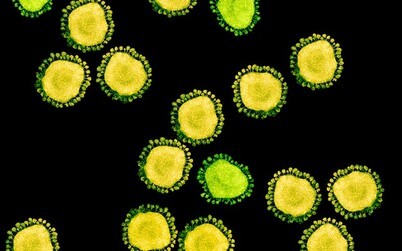
NOTE: as of today, March 26, the United States has surpassed every other country, including China, with 85,486 confirmed cases. I. The Next Months
Having fallen behind, it will be difficult—but not impossible—for the United States to catch up. To an extent, the near-term future is set because COVID-19 is a slow and long illness. People who were infected several days ago will only start showing symptoms now, even if they isolated themselves in the meantime. Some of those people will enter intensive-care units in early April. Last weekend, the nation had 17,000 confirmed cases, and the numbers are rising exponentially. Wednesday morning, the official case count was 54,000, and now, two days later, it’s over 85,000. Health-care workers are already seeing dwindling equipment, overcrowded hospitals, and doctors and nurses who are themselves becoming infected.
Italy and Spain offered grim warnings about the future. Hospitals are out of room, supplies, and staff. Unable to treat or save everyone, doctors have been forced into the unthinkable: rationing care to patients who are most likely to survive, while letting others die.
And here’s a frightening statistic: the U.S. has fewer hospital beds per capita than Italy. A study released by a team at Imperial College London concluded that if the pandemic is left unchecked, those beds will all be full by late April. By the end of June, there will be 15 times as many COVID-19 patients as beds. By the end of the summer, the pandemic will have directly killed 2.2 million Americans, notwithstanding those who will indirectly die as hospitals are unable to care for the usual slew of heart attacks, strokes, and car accidents.
This is the worst-case scenario. To avert it, four things need to happen—and quickly.
The first and most important is to rapidly produce masks, gloves, and other personal protective equipment. If health-care workers can’t stay healthy, the rest of the response will collapse. In some places, stockpiles are already so low that doctors are reusing masks between patients, calling for donations from the public, or sewing their own homemade alternatives. These shortages are happening because medical supplies are made-to-order and depend on byzantine international supply chains that are currently straining and snapping. Hubei province in China, the epicenter of the pandemic, was also a manufacturing center of medical masks.
In the U.S., the Strategic National Stockpile—a national larder of medical equipment—has already been deployed, especially to New York and the other hardest-hit states. The stockpile is not inexhaustible, but it can buy some time. Donald Trump invoker the Defense Production Act, launching a wartime effort in which American manufacturers switch to making medical equipment. But after invoking the act last Wednesday, Trump has failed to actually use it, reportedly due to lobbying from the U.S. Chamber of Commerce and heads of major corporations.
Some manufacturers are already rising to the challenge, but their efforts are piecemeal and unevenly distributed. “One day, we’ll wake up to a story of doctors in City X who are operating with bandanas, and a closet in City Y with masks piled into it,” says Ali Khan, the dean of public health at the University of Nebraska Medical Center. A “massive logistics and supply-chain operation [is] now needed across the country,” says Thomas Inglesby of Johns Hopkins Bloomberg School of Public Health. That can’t be managed by small and inexperienced teams scattered throughout the White House. The solution, he says, is to tag in the Defense Logistics Agency—a 26,000-person group that prepares the U.S. military for overseas operations and that has assisted in past public-health crises, including the 2014 Ebola outbreak.
This agency can also coordinate the second pressing need: a massive rollout of COVID-19 tests. Those tests have been slow to arrive because of five separate shortages: of masks to protect people administering the tests; of nasopharyngeal swabs for collecting viral samples; of extraction kits for pulling the virus’s genetic material out of the samples; of chemical reagents that are part of those kits; and of trained people who can give the tests. Many of these shortages are, again, due to strained supply chains. The U.S. relies on three manufacturers for extraction reagents, providing redundancy in case any of them fails—but all of them failed in the face of unprecedented global demand. Meanwhile, Lombardy, Italy, the hardest-hit place in Europe, houses one of the largest manufacturers of nasopharyngeal swabs.
Some shortages are being addressed. The FDA is now moving quickly to approve tests developed by private labs. At least one can deliver results in less than an hour, potentially allowing doctors to know if the patient in front of them has COVID-19. The country “is adding capacity on a daily basis,” says Kelly Wroblewski of the Association of Public Health Laboratories.
On March 6, Trump said that “anyone who wants a test can get a test.” That was (and still is) untrue, and his own officials were quick to correct him. Regardless, anxious people still flooded into hospitals, seeking tests that did not exist. “People wanted to be tested even if they weren’t symptomatic, or if they sat next to someone with a cough,” says Saskia Popescu of George Mason University, who works to prepare hospitals for pandemics. Others just had colds, but doctors still had to use masks to examine them, burning through their already dwindling supplies. “It really stressed the health-care system,” Popescu says. Even now, as capacity expands, tests must be used carefully. The first priority, says Marc Lipsitch of Harvard, is to test health-care workers and hospitalized patients, allowing hospitals to quell any ongoing fires. Only later, once the immediate crisis is slowing, should tests be deployed in a more widespread way. “This isn’t just going to be: Let’s get the tests out there!” Inglesby says.
These measures will take time, during which the pandemic will either accelerate beyond the capacity of the health system, or slow to containable levels.
Its course—and the nation’s fate—now depends on the third need, which is social distancing. Think of it this way: There are now only two groups of Americans. Group A includes everyone involved in the medical response, whether that’s treating patients, running tests, or manufacturing supplies. Group B includes everyone else, and their job is to buy Group A more time. Group B must now “flatten the curve” by physically isolating themselves from other people to cut off chains of transmission. Given the slow fuse of COVID-19, to forestall the future collapse of the health-care system, these seemingly drastic steps must be taken immediately, before they feel proportionate, and they must continue for several weeks.
Persuading a country to voluntarily stay at home is not easy, and with mixed messages and no clear guidelines from the White House, mayors, governors, and business owners have been forced to take their own steps. Some states have banned large gatherings or closed schools and restaurants. At least 25 have now instituted some form of quarantine, either mandatory or recommended, compelling people to stay at home. And yet many citizens continue to crowd into public spaces.
In these moments, when the good of all hinges on the sacrifices of many, clear coordination matters—the fourth urgent need. The importance of social distancing must be impressed upon a public who must also be reassured and informed. Instead, Trump has repeatedly played down the problem, telling America that “we have it very well under control” when we do not, and that cases were “going to be down to close to zero” when they were rising. In some cases, as with his claims about ubiquitous testing, his misleading gaffes have deepened the crisis. He has even touted unproven medications.
Away from the White House press room, Trump has apparently been listening to Anthony Fauci, the director of the National Institute of Allergy and Infectious Diseases. Fauci has advised every president since Ronald Reagan on new epidemics, and now sits on the COVID-19 task force that meets with Trump roughly every other day. “He’s got his own style, let’s leave it at that,” Fauci told me, “but any kind of recommendation that I have made thus far, the substance of it, he has listened to everything.”
But Trump already seems to be wavering. This week he has signaled that he is prepared to backtrack on social-distancing policies, perhaps as early as Easter. Pundits and business leaders have used similar rhetoric, arguing that high-risk people, such as the elderly, could be protected while lower-risk people are allowed to go back to work. Such thinking is seductive, but flawed. It overestimates our ability to assess a person’s risk, and to somehow wall off the ‘high-risk’ people from the rest of society. It underestimates how badly the virus can hit ‘low-risk’ groups, and how thoroughly hospitals will be overwhelmed if even just younger demographics are falling sick.
A recent analysis from the University of Pennsylvania estimated that even if social-distancing measures can reduce infection rates by 95 percent, 960,000 Americans will still need intensive care. There are only about 180,000 ventilators in the U.S. and, more pertinently, only enough respiratory therapists and critical-care staff to safely look after 100,000 ventilated patients. Abandoning social distancing would be foolish. Abandoning it now, when tests and protective equipment are still scarce, would be catastrophic.
If Trump stays the course, if Americans adhere to social distancing, if testing can be rolled out, and if enough masks can be produced, there is a chance that the country can still avert the worst predictions about COVID-19, and at least temporarily bring the pandemic under control. No one knows how long that will take, but it won’t be quick. “It could be anywhere from four to six weeks to up to three months,” Fauci said, “but I don’t have great confidence in that range.”
II. The Endgame
Even a perfect response won’t end the pandemic. As long as the virus persists somewhere, there’s a chance that one infected traveler will reignite fresh sparks in countries that have already extinguished their fires. This is already happening in China, Singapore, and other Asian countries that briefly seemed to have the virus under control. Under these conditions, there are three possible endgames: one that’s very unlikely, one that’s very dangerous, and one that’s very long.
The first is that every nation manages to simultaneously bring the virus to heel, as with the original SARS in 2003. Given how widespread the coronavirus pandemic is, and how badly many countries are faring, the odds of worldwide synchronous control seem vanishingly small.
The second is that the virus does what past flu pandemics have done: It burns through the world and leaves behind enough immune survivors that it eventually struggles to find viable hosts. This “herd immunity” scenario would be quick, and thus tempting. But it would also come at a terrible cost: SARS-CoV-2 is more transmissible and fatal than the flu, and it would likely leave behind many millions of corpses and a trail of devastated health systems. The United Kingdom initially seemed to consider this herd-immunity strategy, before backtracking when models revealed the dire consequences. The U.S. now seems to be considering it too.
The third scenario is that the world plays a protracted game of whack-a-mole with the virus, stamping out outbreaks here and there until a vaccine can be produced. This is the best option, but also the longest and most complicated.
It depends, for a start, on making a vaccine. If this were a flu pandemic, that would be easier. The world is experienced at making flu vaccines and does so every year. But there are no existing vaccines for coronaviruses—until now, these viruses seemed to cause diseases that were mild or rare—so researchers must start from scratch. The first steps have been impressively quick. Last Monday, a possible vaccine created by Moderna and the National Institutes of Health went into early clinical testing. That marks a 63-day gap between scientists sequencing the virus’s genes for the first time and doctors injecting a vaccine candidate into a person’s arm. “It’s overwhelmingly the world record,” Fauci said.
But it’s also the fastest step among many subsequent slow ones. The initial trial will simply tell researchers if the vaccine seems safe, and if it can actually mobilize the immune system. Researchers will then need to check that it actually prevents infection from SARS-CoV-2. They’ll need to do animal tests and large-scale trials to ensure that the vaccine doesn’t cause severe side effects. They’ll need to work out what dose is required, how many shots people need, if the vaccine works in elderly people, and if it requires other chemicals to boost its effectiveness.
“Even if it works, they don’t have an easy way to manufacture it at a massive scale,” said Seth Berkley of Gavi. That’s because Moderna is using a new approach to vaccination. Existing vaccines work by providing the body with inactivated or fragmented viruses, allowing the immune system to prep its defenses ahead of time. By contrast, Moderna’s vaccine comprises a sliver of SARS-CoV-2’s genetic material—its RNA. The idea is that the body can use this sliver to build its own viral fragments, which would then form the basis of the immune system’s preparations. This approach works in animals, but is unproven in humans. By contrast, French scientists are trying to modify the existing measles vaccine using fragments of the new coronavirus. “The advantage of that is that if we needed hundreds of doses tomorrow, a lot of plants in the world know how to do it,” Berkley said. No matter which strategy is faster, Berkley and others estimate that it will take 12 to 18 months to develop a proven vaccine, and then longer still to make it, ship it, and inject it into people’s arms.
It’s likely, then, that the new coronavirus will be a lingering part of American life for at least a year, if not much longer. If the current round of social-distancing measures works, the pandemic may ebb enough for things to return to a semblance of normalcy. Offices could fill and bars could bustle. Schools could reopen and friends could reunite. But as the status quo returns, so too will the virus. This doesn’t mean that society must be on continuous lockdown until 2022. But “we need to be prepared to do multiple periods of social distancing,” says Stephen Kissler of Harvard.
Much about the coming years, including the frequency, duration, and timing of social upheavals, depends on two properties of the virus, both of which are currently unknown. First: seasonality. Coronaviruses tend to be winter infections that wane or disappear in the summer. That may also be true for SARS-CoV-2, but seasonal variations might not sufficiently slow the virus when it has so many immunologically naive hosts to infect. “Much of the world is waiting anxiously to see what—if anything—the summer does to transmission in the Northern Hemisphere,” says Maia Majumder of Harvard Medical School and Boston Children’s Hospital.
Second: duration of immunity. When people are infected by the milder human coronaviruses that cause cold-like symptoms, they remain immune for less than a year. By contrast, the few who were infected by the original SARS virus, which was far more severe, stayed immune for much longer. Assuming that SARS-CoV-2 lies somewhere in the middle, people who recover from their encounters might be protected for a couple of years. To confirm that, scientists will need to develop accurate serological tests, which look for the antibodies that confer immunity. They’ll also need to confirm that such antibodies actually stop people from catching or spreading the virus. If so, immune citizens can return to work, care for the vulnerable, and anchor the economy during bouts of social distancing.
Scientists can use the periods between those bouts to develop antiviral drugs—although such drugs are rarely panaceas, and come with possible side effects and the risk of resistance. Hospitals can stockpile the necessary supplies. Testing kits can be widely distributed to catch the virus’s return as quickly as possible. There’s no reason that the U.S. should let SARS-CoV-2 catch it unawares again, and thus no reason that social-distancing measures need to be deployed as broadly and heavy-handedly as they now must be. As Aaron E. Carroll and Ashish Jha recently wrote, “We can keep schools and businesses open as much as possible, closing them quickly when suppression fails, then opening them back up again once the infected are identified and isolated. Instead of playing defense, we could play more offense.”
Whether through accumulating herd immunity or the long-awaited arrival of a vaccine, the virus will find spreading explosively more and more difficult. It’s also unlikely to disappear entirely. The vaccine may need to be updated as the virus changes, and people may need to get revaccinated on a regular basis, as they currently do for the flu. Models suggest that the virus might simmer around the world, triggering epidemics every few years or so. “But my hope and expectation is that the severity would decline, and there would be less societal upheaval,” Kissler says. In this future, COVID-19 may become like the flu is today—a recurring scourge of winter. Perhaps it will eventually become so mundane that even though a vaccine exists, large swaths of Gen C won’t bother getting it, forgetting how dramatically their world was molded by its absence.
III. The Aftermath
The cost of reaching that point, with as few deaths as possible, will be enormous. As my colleague Annie Lowrey wrote, the economy is experiencing a shock “more sudden and severe than anyone alive has ever experienced.” About one in five people in the United States have lost working hours or jobs. Hotels are empty. Airlines are grounding flights. Restaurants and other small businesses are closing. Inequalities will widen: People with low incomes will be hardest-hit by social-distancing measures, and most likely to have the chronic health conditions that increase their risk of severe infections. Diseases have destabilized cities and societies many times over, “but it hasn’t happened in this country in a very long time, or to quite the extent that we’re seeing now,” says Elena Conis, a historian of medicine at UC Berkeley. “We’re far more urban and metropolitan. We have more people traveling great distances and living far from family and work.”
After infections begin ebbing, a secondary pandemic of mental-health problems will follow. At a moment of profound dread and uncertainty, people are being cut off from soothing human contact. Hugs, handshakes, and other social rituals are now tinged with danger. People with anxiety or obsessive-compulsive disorder are struggling. Elderly people, who are already excluded from much of public life, are being asked to distance themselves even further, deepening their loneliness. Asian people are suffering racist insults, fueled by a president who insists on labeling the new coronavirus the “Chinese virus.” Incidents of domestic violence and child abuse are likely to spike as people are forced to stay in unsafe homes. Children, whose bodies are mostly spared by the virus, may endure mental trauma that stays with them into adulthood.
After the pandemic, people who recover from COVID-19 might be shunned and stigmatized, as were survivors of Ebola, SARS, and HIV. Health-care workers will take time to heal: One to two years after SARS hit Toronto, people who dealt with the outbreak were still less productive and more likely to be experiencing burnout and post-traumatic stress. People who went through long bouts of quarantine will carry the scars of their experience. “My colleagues in Wuhan note that some people there now refuse to leave their homes and have developed agoraphobia,” says Steven Taylor of the University of British Columbia, who wrote The Psychology of Pandemics.
But “there is also the potential for a much better world after we get through this trauma,” says Richard Danzig of the Center for a New American Security. Already, communities are finding new ways of coming together, even as they must stay apart. Attitudes to health may also change for the better. The rise of HIV and AIDS “completely changed sexual behavior among young people who were coming into sexual maturity at the height of the epidemic,” Conis says. “The use of condoms became normalized. Testing for STDs became mainstream.” Similarly, washing your hands for 20 seconds, a habit that has historically been hard to enshrine even in hospitals, “may be one of those behaviors that we become so accustomed to in the course of this outbreak that we don’t think about them,” Conis adds.
Pandemics can also catalyze social change. People, businesses, and institutions have been remarkably quick to adopt or call for practices that they might once have dragged their heels on, including working from home, conference-calling to accommodate people with disabilities, proper sick leave, and flexible child-care arrangements. “This is the first time in my lifetime that I’ve heard someone say, ‘Oh, if you’re sick, stay home,’” says Adia Benton, an anthropologist at Northwestern University. Perhaps the nation will learn that preparedness isn’t just about masks, vaccines, and tests, but also about fair labor policies and a stable and equal health-care system. Perhaps it will appreciate that health-care workers and public-health specialists compose America’s social immune system, and that this system has been suppressed.
Aspects of America’s identity may need rethinking after COVID-19. Many of the country’s values have seemed to work against it during the pandemic. Its individualism, exceptionalism, and tendency to equate doing whatever you want with an act of resistance meant that when it came time to save lives and stay indoors, some people flocked to bars and clubs. Having internalized years of anti-terrorism messaging following 9/11, Americans resolved to not live in fear. But SARS-CoV-2 has no interest in their terror, only their cells.
Years of isolationist rhetoric had consequences too. Citizens who saw China as a distant, different place, where bats are edible and authoritarianism is acceptable, failed to consider that they would be next or that they wouldn’t be ready. (China’s response to this crisis had its own problems, but that’s for another time.) “People believed the rhetoric that containment would work,” says Wendy Parmet, who studies law and public health at Northeastern University. “We keep them out, and we’ll be okay. When you have a body politic that buys into these ideas of isolationism and ethnonationalism, you’re especially vulnerable when a pandemic hits.”
Veterans of past epidemics have long warned that American society is trapped in a cycle of panic and neglect. After every crisis—anthrax, SARS, flu, Ebola—attention is paid and investments are made. But after short periods of peacetime, memories fade and budgets dwindle. This trend transcends red and blue administrations. When a new normal sets in, the abnormal once again becomes unimaginable. But there is reason to think that COVID-19 might be a disaster that leads to more radical and lasting change.
The other major epidemics of recent decades either barely affected the U.S. (SARS, MERS, Ebola), were milder than expected (H1N1 flu in 2009), or were mostly limited to specific groups of people (Zika, HIV). The COVID-19 pandemic, by contrast, is affecting everyone directly, changing the nature of their everyday life. That distinguishes it not only from other diseases, but also from the other systemic challenges of our time. When an administration prevaricates on climate change, the effects won’t be felt for years, and even then will be hard to parse. It’s different when a president says that everyone can get a test, and one day later, everyone cannot. Pandemics are democratizing experiences. People whose privilege and power would normally shield them from a crisis are facing quarantines, testing positive, and losing loved ones. Senators are falling sick. The consequences of defunding public-health agencies, losing expertise, and stretching hospitals are no longer manifesting as angry opinion pieces, but as faltering lungs.
After 9/11, the world focused on counterterrorism. After COVID-19, attention may shift to public health. Expect to see a spike in funding for virology and vaccinology, a surge in students applying to public-health programs, and more domestic production of medical supplies. Expect pandemics to top the agenda at the United Nations General Assembly. Anthony Fauci is now a household name. “Regular people who think easily about what a policewoman or firefighter does finally get what an epidemiologist does,” says Monica Schoch-Spana, a medical anthropologist at the Johns Hopkins Center for Health Security.
Such changes, in themselves, might protect the world from the next inevitable disease. “The countries that had lived through SARS had a public consciousness about this that allowed them to leap into action,” said Ron Klain, the former Ebola czar. “The most commonly uttered sentence in America at the moment is, ‘I’ve never seen something like this before.’ That wasn’t a sentence anyone in Hong Kong uttered.” For the U.S., and for the world, it’s abundantly, viscerally clear what a pandemic can do.
The lessons that America draws from this experience are hard to predict, especially at a time when online algorithms and partisan broadcasters only serve news that aligns with their audience’s preconceptions. Such dynamics will be pivotal in the coming months, says Ilan Goldenberg, a foreign-policy expert at the Center for a New American Security. “The transitions after World War II or 9/11 were not about a bunch of new ideas,” he says. “The ideas are out there, but the debates will be more acute over the next few months because of the fluidity of the moment and willingness of the American public to accept big, massive changes.”
One could easily conceive of a world in which most of the nation believes that America defeated COVID-19. Despite his many lapses, Trump’s approval rating has surged. Imagine that he succeeds in diverting blame for the crisis to China, casting it as the villain and America as the resilient hero. During the second term of his presidency, the U.S. turns further inward and pulls out of NATO and other international alliances, builds actual and figurative walls, and disinvests in other nations. As Gen C grows up, foreign plagues replace communists and terrorists as the new generational threat.
One could also envisage a future in which America learns a different lesson. A communal spirit, ironically born through social distancing, causes people to turn outward, to neighbors both foreign and domestic. The election of November 2020 becomes a repudiation of “America first” politics. The nation pivots, as it did after World War II, from isolationism to international cooperation. Buoyed by steady investments and an influx of the brightest minds, the health-care workforce surges. Gen C kids write school essays about growing up to be epidemiologists. Public health becomes the centerpiece of foreign policy. The U.S. leads a new global partnership focused on solving challenges like pandemics and climate change.
Published on March 25, 2020 17:24



